United States Institute of Peace
National high school essay contest.
USIP partners with the American Foreign Service Association (AFSA) on the annual National High School Essay Contest. The contest each year engages high school students in learning and writing about issues of peace and conflict, encouraging appreciation for diplomacy’s role in building partnerships that can advance peacebuilding and protect national security.
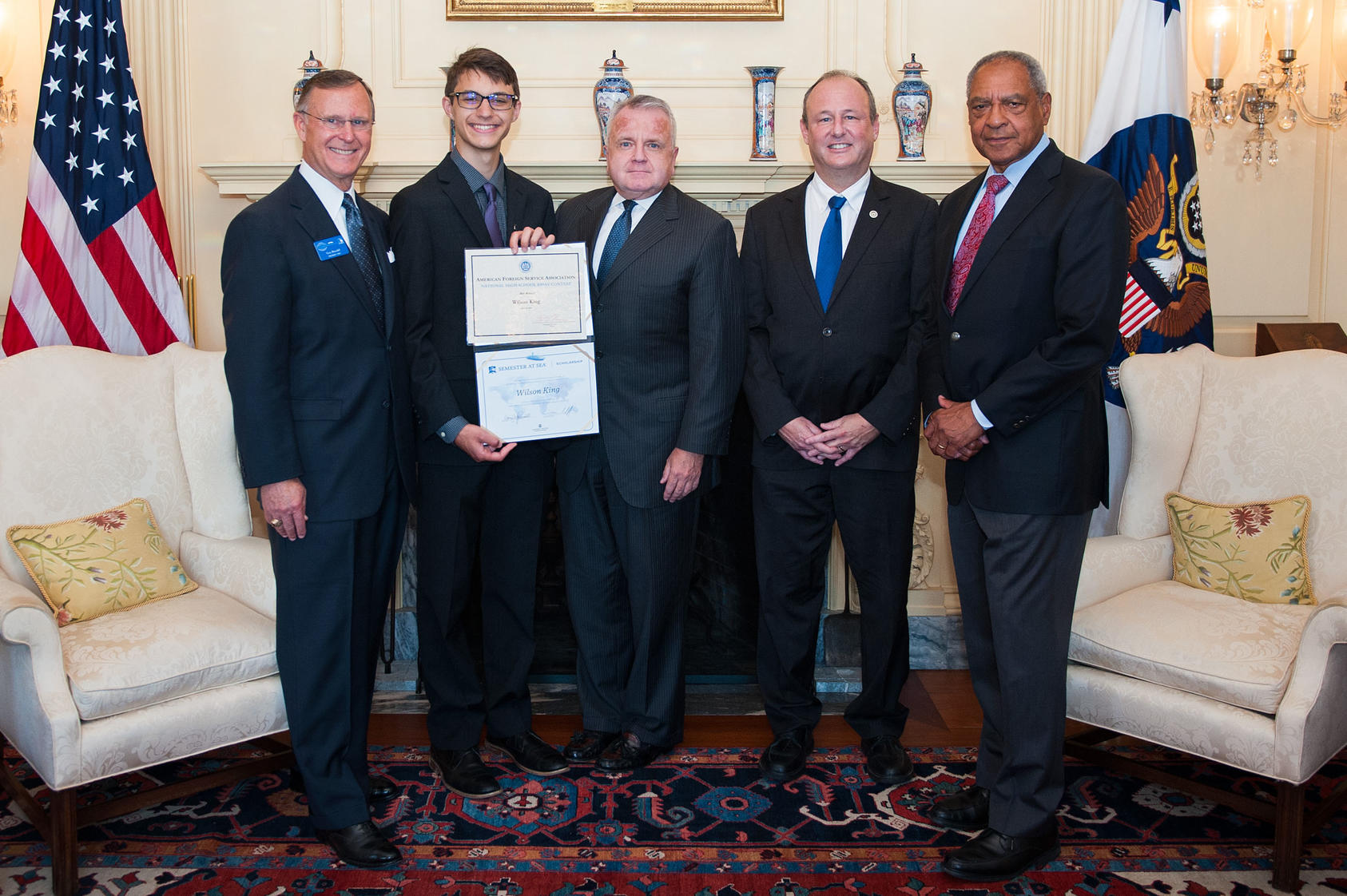
The winner of the contest receives a $2,500 cash prize, an all-expense paid trip to Washington, D.C. to meet U.S. Department of State and USIP leadership, and a full-tuition paid voyage with Semester at Sea upon the student’s enrollment at an accredited university. The runner-up receives a $1,250 cash prize and a full scholarship to participate in the International Diplomacy Program of the National Student Leadership Conference.

2023 National High School Essay Contest
The American Foreign Service Association’s national high school essay contest completed its twenty-third year with over 400 submissions from 44 states. Three randomized rounds of judging produced this year’s winner, Justin Ahn, a junior from Deerfield Academy in Deerfield, Massachusetts. In his essay, “Mending Bridges: U.S.-Vietnam Reconciliation from 1995 to Today,” Ahn focuses on the successful reconciliation efforts by the Foreign Service in transforming U.S.-Vietnam relations from post-war tension to close economic and strategic partnership.
Ahn will travel to Washington, D.C. to meet with a member of the Department of State’s leadership and receive a full tuition scholarship to an educational voyage with Semester at Sea.
Niccolo Duina was this year’s runner-up. He is currently a junior at Pulaski Academy in Little Rock, Arkansas. Duina will be attending the international diplomacy program of the National Student Leadership Conference this summer.
There were eight honorable mentions:
- Santiago Castro-Luna – Chevy Chase, Maryland
- Dante Chittenden – Grimes, Iowa
- Merle Hezel – Denver, Colorado
- Adarsh Khullar – Villa Hills, Kentucky
- Nicholas Nall – Little Rock, Arkansas
- Ashwin Telang – West Windsor, New Jersey
- Himani Yarlagadda – Northville, Michigan
- Sophia Zhang – San Jose, California
Congratulations! We thank all students and teachers who took the time to research and become globally engaged citizens who care about diplomacy, development and peacebuilding.
2023 National High School Essay Contest Topic
In 2024, the U.S. Foreign Service will celebrate its 100th birthday. The Foreign Service is an important element of the American approach to peacebuilding around the world. Over the last century, U.S. diplomats have been involved in some of the most significant events in history — making decisions on war and peace, responding to natural disasters and pandemics, facilitating major treaties, and more.
As AFSA looks back on their century-long history, we invite you to do the same. This year, students are asked to explore a topic that touches upon this important history and sheds light on how vital it is for America to have a robust professional corps focused on diplomacy, development and peace in the national interest.
In your essay, you will select a country or region in which the U.S. Foreign Service has been involved in at any point since 1924 and describe — in 1,500 words or less — how the Foreign Service was successful or unsuccessful in advancing American foreign policy goals, including promoting peace, in this country/region and propose ways in which it might continue to improve those goals in the coming years.
Contest deadline: April 3, 2023
Download the study guide for the 2023 National High School Essay Contest. This study guide provides students with a basic introduction to the topic and some additional context that can assist them in answering the question. It includes the essay question, prizes and rules for the contest; an introduction to diplomacy and peacebuilding; key terms; topics and areas students might explore; and a list of other useful resources.
Learn more about the contest rules and how to submit your essay on the American Foreign Service Association’s contest webpage .
2022 National High School Essay Contest
Katherine Lam, a freshman from University High School in Tucson, Arizona, is the 2022 National High School Essay Contest winner. In her essay, “Competition and Coaction in Ethiopia: U.S. and Chinese Partnerships for International Stabilization,” Lam focuses on how the Foreign Service has partnered with other U.S. government agencies, nongovernmental organizations and — most notably — China to promote peace and development in Ethiopia. Lam will travel to Washington, D.C., to meet with a member of the U.S. Department of State’s leadership and gain full tuition for an educational voyage with Semester at Sea.
Olivia Paulsen was this year’s runner-up. She is a currently a junior receiving a home-schooled education in Concord, Massachusetts. Paulsen will be attending the international diplomacy program of the National Student Leadership Conference this summer.
The 2022 honorable mentions were: Josh Diaz (Little Rock, AR); Grace Hartman (Bethlehem, PA); Elena Higuchi (Irvine, CA); Ovea Kaushik (Oklahoma City, OK); Evan Lindemann (Palm Desert, CA); Percival Liu (Tokyo, Japan); Alexander Richter (San Jose, CA); and Gavin Sun (Woodbury, MN).
USIP congratulates all the winners of the 2022 National High School Essay Contest.
Partnerships for Peace in a Multipolar Era
The current multipolar era poses challenges for U.S. foreign policy but also provides new opportunities for partnership across world powers—including emerging great powers like China and Russia—to build peace in conflict-affected countries. Describe a current situation where American diplomats and peacebuilders are working with other world powers, as well as local and/or regional actors, in a conflict-affected country to champion democracy, promote human rights, and/or resolve violent conflict. A successful essay will lay out the strategies and tactics U.S. Foreign Service Officers and American peacebuilders are employing to build successful partnerships with other world and regional powers and with local actors in the chosen current situation. The essay will also describe specific ways that these partnerships are helping to promote stability and build peace.
Contest deadline: April 4, 2022
Download the study guide for the 2022 National High School Essay Contest. This study guide provides students with a basic introduction to the topic and some additional context that can assist them in answering the question. It includes the essay question, prizes, and rules for the contest; an introduction to diplomacy and peacebuilding; key terms; topics and areas students might explore; and a list of other useful resources.
Learn more about the contest rules and how to submit your essay on the American Foreign Service Association’s contest webpage.
2021 National High School Essay Contest
Mariam Parray, a sophomore from Pulaski Academy in Little Rock, Arkansas, is the 2021 National High School Essay Contest winner. In her essay, “Diplomats and Peacebuilders in Tunisia: Paving the Path to Democracy,” Ms. Parray focuses on how the Foreign Service partnered with other U.S. government agencies and NGOs to effect a peaceful democratic transition in Tunisia. She emphasizes the importance of multifaceted approaches as well as the importance of bringing marginalized groups into the fold. Mariam will travel to Washington to meet with a member of the Department of State’s leadership and will also gain a full tuition to an educational voyage with Semester at Sea. Harrison McCarty was this year’s runner-up. Coincidentally, he is also a sophomore from Pulaski Academy in Little Rock, Arkansas. Harrison will be attending the international diplomacy program of the National Student Leadership Conference this summer. The 2021 honorable mentions were: Louisa Eaton (Wellesley, MA); Samuel Goldston (Brooklyn, NY); Lucy King (Bainbridge Island, WA); Haan Jun Lee (Jakarta, Indonesia); Khaled Maalouf (Beirut, Lebanon); Madeleine Shaw (Bloomington, IN); Allison Srp (Austin, MN); and Daniel Zhang (Cortland, NY).
USIP congratulates all the winners of the 2021 National High School Essay Contest.
Diplomats and Peacebuilders: Powerful Partners
What characteristics lead to a successful effort by diplomats and peacebuilders to mediate or prevent violent conflict? The United States Foreign Service—often referred to as America’s first line of defense—works to prevent conflict from breaking out abroad and threats from coming to our shores. Peacebuilders work on the ground to create the conditions for peace and resolve conflicts where they are most needed.
Successful essays will identify, in no more than 1,250 words, a situation where diplomats worked on a peacebuilding initiative with partners from the country/region in question, nongovernmental organizations, and other parts of the U.S. government, and then go on to analyze what characteristics and approaches made the enterprise a success.
Contest deadline: April 5, 2021
Download the study guide for the 2021 National High School Essay Contest. This study guide provides students with a basic introduction to the topic and some additional context that can assist them in answering the question. It includes key terms in conflict management and peacebuilding and examples of peacebuilding initiatives, with reflection questions for independent learners to dig more deeply or for teachers to encourage class reflection and discussion. We hope this study guide will be a useful resource for educators and students participating in this contest, and for educators who want their students to learn more about this year’s contest topic.
2020 National High School Essay Contest
Jonas Lorincz, a junior from Marriotts Ridge High School in Marriottsville, MD, is the 2020 National High School Essay Contest winner. In his essay, “Verification, Mediation, and Peacebuilding: The Many Roles of the U.S. Foreign Service in Kosovo,” Mr. Lorincz focused on the importance of interagency cooperation in mediating the crisis in Kosovo – primarily looking into how diplomats and other civilian agencies engaged in peacebuilding throughout the conflict.
Claire Burke was this year’s runner-up. She is a junior at Mill Valley High School in Shawnee, KS.
The 2020 honorable mentions were: Grace Cifuentes (Concord, CA), Grace Lannigan (Easton, CT), Seryung Park (Tenafly, NJ), Vynateya Purimetla (Troy, MI), David Richman (Norfolk, VA), Madeleine Shaw (Bloomington, IN), Sara Smith (Fargo, ND), and Jack Viscuso (Northport, NY). USIP congratulates all the winners of the 2020 National High School Essay Contest.
2020 National High School Essay Contest Topic
Why Diplomacy and Peacebuilding Matter
How do members of the Foreign Service work with other civilian parts of the U.S. Government to promote peace, national security and economic prosperity?
Qualified essays focused on a specific challenge to U.S. peace and prosperity and included one example of the work of the Foreign Service and one or more examples of collaboration between America’s diplomats and other civilian (i.e. non-military) U.S. Government agencies or organizations.
2019 National High School Essay Contest
In its 21st year, the American Foreign Service Association (AFSA)’s National High School Essay Contest encouraged students to think about how and why the United States engages globally to build peace, and about the role that the Foreign Service plays in advancing U.S. national security and economic prosperity.
For the second year in a row, the National High School Essay Contest focused on an important aspect of operating in countries affected by or vulnerable to violent conflict: effective coordination of the many different foreign policy tools the United States has at its disposal. Whether you were addressing the prompt for a second year or new to the contest, the contest will have challenged you to expand your understanding of the role of the Foreign Service and other actors in foreign policy, identify case studies, and provide a sophisticated analysis in a concise manner.
The essay prompt and a helpful study guide are included below; you can find out more information about the rules and how to submit by checking out AFSA’s essay contest page .
2019 Essay Question
The United States has many tools to advance and defend its foreign policy and national security interests around the world—from diplomatic approaches pursued by members of the Foreign Service, to the range of options available to the U.S. military. In countries affected by or vulnerable to violent conflict, peacebuilding tools are important additions to the national security toolkit.
In such complex environments, cooperation across agencies and approaches is challenging, but it can also blend knowledge and skills in ways that strengthen the overall effort to establish a lasting peace. On the other hand, lack of coordination can lead to duplication of effort, inefficient use of limited resources and unintended consequences.
In a 1,000-1,250-word essay, identify two cases—one you deem successful and one you deem unsuccessful—where the U.S. pursued an integrated approach to build peace in a conflict-affected country. Analyze and compare these two cases, addressing the following questions:
- What relative strengths did members of the Foreign Service and military actors bring to the table? What peacebuilding tools were employed? Ultimately, what worked or did not work in each case?
- How was each situation relevant to U.S. national security interests?
- What lessons may be drawn from these experiences for the pursuit of U.S. foreign policy more broadly?
Download the study guide for the 2019 AFSA National High School Essay Contest
2018 National High School Essay Contest
Jennifer John from Redwood City, CA is the 2018 National High School Essay Contest winner, surpassing close to 1,000 other submissions. Her essay examined to what extent U.S. interagency efforts in Iraq and Bosnia were successful in building peace. Aislinn Niimi from Matthews, NC was the runner up.
The 2018 honorable mentions were: Alex, DiCenso (North Kingstown, RI),Alexandra Soo (Franklin, MI), Caroline Bellamy (Little Rock AR), Colin LeFerve (Indianapolis, IN), Elizabeth Kam (Burlingham, CA), Emma Singh (Tenafly NJ), Emma Chambers (Little Rock AR), Francesca Ciampa (Brooksville, ME), Greta Bunce (Franktown, VA), Isaac Che (Mount Vernon OH), Isabel Davis (Elk River MN), Katrina Espinoza (Watsonvile, CA), Molly Ehrig (Bethlehem, PA), Payton McGoldrick (Bristow, VA), Rachel Russell (Cabin John, MD), Sarah Chapman (Tucson, AZ), Shalia Lothe (Glen Allen VA), Sohun Modha (San Jose CA), Suhan Kacholia (Chandler, AZ), Supriya Sharma (Brewster, NY), Sydney Adams (Fort Wayne, IN), Tatum Smith (Little Rock AR), and William Milne (Fort Wayne, IN).
2017 National High School Essay Contest
Nicholas Deparle, winner of the 2017 AFSA National High School Essay Contest, comes from Sidwell Friends School in Washington DC. A rising senior at the time, Mr. Deparle covers the Internally Displaced Persons crisis in Iraq and potential ideas to help resolve the issue. Read his winning essay here . Mr. Manuel Feigl, a graduate of Brashier Middle College Charter High School in Simpsonville, SC took second place.
This year there were twenty honorable mentions: Mohammed Abuelem ( Little Rock, Ark.), Lucas Aguayo-Garber (Worcester, Mass.), Rahul Ajmera (East Williston, N.Y.), Taylor Gregory (Lolo, Mont.), Rachel Hildebrand (Sunnyvale, Calif.), Ryan Hulbert (Midland Park, N.J.), India Kirssin (Mason, Ohio), Vaibhav Mangipudy (Plainsboro, N.J.), William Marsh (Pittsburgh, Penn.), Zahra Nasser (Chicago, Ill.), Elizabeth Nemec (Milford, N.J.), David Oks (Ardsley, N.Y.), Max Pumilia (Greenwood Village, Colo.), Nikhil Ramaswamy (Plano, Texas), Aditya Sivakumar (Beaverton, Ore.), Donovan Stuard (Bethlehem, Penn.), Rachel Tanczos (Danielsville, Penn.), Isabel Ting (San Ramon, Calif.), Kimberley Tran (Clayton, Mo.), and Chenwei Wang (Walnut, Calif.).
2017 Essay Contest Topic
According to the United Nations, 65 million people worldwide have left their homes to seek safety elsewhere due to violence, conflict, persecution, or human rights violations. The majority of these people are refugees or internally displaced persons (IDPs).
Imagine you are a member of the U.S. Foreign Service —– a diplomat working to promote peace, support prosperity, and protect American citizens while advancing the interests of the United States abroad – and are now assigned to the U.S. embassy in one of these four countries.
- Turkey (Bureau of European and Eurasian Affairs)
- Kenya (Bureau of African Affairs)
- Afghanistan (Bureau of South and Central Asian Affairs)
- Iraq (Bureau of Near Eastern Affairs)
Your task is to provide recommendations to address the refugee/IDP crisis facing the country in which you are now posted. Using the resources available to you as a member of the Foreign Service, write a memo to your Ambassador outlining how the United States might help address the current unprecedented levels of displacement. You may choose to address issues related to the causes of refugee crisis, or to focus on the humanitarian crisis in your host country.
A qualifying memo will be 1,000-1,250 words and will answer the following questions:
- How does the crisis challenge U.S. interests in the country you are posted and more broadly?
- Specifically outline the steps you propose the U.S. should take to tackle the roots or the consequences of the crisis, and explain how it would help solve the issue or issues you are examining. How will your efforts help build peace or enhance stability?
- How do you propose, from your embassy/post of assignment, to foster U.S. government interagency cooperation and cooperation with the host-country government to address these issues? Among U.S. government agencies, consider U.S. Agency for International Development, the Foreign Commercial Service and the U.S. Institute of Peace.
Memo Template
TO: Ambassador ______________________
FROM: Only use your first name here
RE: Think of this as your title, make sure to include the country you are writing about
Here you want to lay out the problem, define criteria by which you will be deciding the best steps the U.S. could take, and include a short sentence or two on your final recommendation. Embassy leadership is very busy and reads many memos a day —– they should be able to get the general ““gist”” of your ideas by reading this section.
Background:
This section should provide any background information about the crisis or conflict relevant to your proposed policy. Here, you should mention why the issue is important to U.S. interests, especially peace and security.
Proposed Steps:
This is where you outline your proposed policy. Be specific in describing how the U.S. might address this issue and how these steps can contribute to peace and security. Include which organizations you propose partnering with and why.
Recommendation:
This is where you write your final recommendations for embassy leadership. Think of this as a closing paragraph.
Companion Guide for the 2017 National High School Essay Contest
It is no easy task to jump into the role of a diplomat, especially when confronted by such an urgent crisis. USIP, in consultation with AFSA, developed a guide to provide a basic introduction to the topic and some additional context that can assist you in answering the question, while still challenging you to develop your own unique response. As such, this guide should be used as a starting point to your own research and as you ultimately prepare a compelling memo outlining recommendations the U.S. government should follow to respond to the refugee and IDP crisis.
In the guide you will find: insights into the role of the Foreign Service; country, organization, and key-term briefs to provide a foundational understanding; and a list of other useful resources. Download the Companion Guide for the 2017 National High School Essay Contest (.pdf).
2016 National High School Essay Contest
USIP first partnered with AFSA for the 2016 contest and was pleased to welcome winner Dylan Borne to Washington in August. His paper describes his role as an economic officer in the U.S. Agency for International Development’s Bureau for Democracy, Conflict and Humanitarian Assistance. He writes about promoting education for girls in Afghanistan through on-line courses and dispersal of laptops. Read his winning essay (.pdf).
2021 NATIONAL HIGH SCHOOL - Diplomats and Peacebuilders: American ...
- Download HTML
- Download PDF

- Current Events

- Uncategorized

- IT & Technique

- Health & Fitness

- Government & Politics

- Home & Garden

- Food & Drink

- Hobbies & Interests

- Arts & Entertainment
What are your chances of acceptance?
Calculate for all schools, your chance of acceptance.
Your chancing factors
Extracurriculars.
The CollegeVine Ultimate Guide to High School Writing Contests

Do you have a plan for applying to college?
With our free chancing engine, admissions timeline, and personalized recommendations, our free guidance platform gives you a clear idea of what you need to be doing right now and in the future.
There are some unique skills that are harder than others to capture on the college application. Students who excel at sports will often have a long list of tangible achievements. Students who produce fine arts or participate in student leadership programs will easily find ways to highlight their participation in these extracurriculars on college applications. But writers will often have a harder time highlighting the skills, time, and energy put into perfecting the craft of writing. If you are a student who excels at writing, how can you draw attention to your abilities and dedication on your college application? Are high grades in the humanities and a well-written essay enough? How can you show that this skill is something you pursue as an extracurricular activity outside of regular school hours?
Writing contests are a great way to highlight your dedication to and success in writing.
Winning a writing contest does much more than simply look good on your college application. Many serious writing contests at the high school level offer prizes. Some are cash awards, and others come in the form of a scholarship, often to a summer writing program . Winning a writing contest can also help you to form and nurture a lasting relationship with the institute that hosts the contest. Additionally, numerous writing contests offer multiple levels of recognition, so you do not have to be the top winner to earn a title that will look good on your college application.
Although winning a writing contest is not easy, it can be the perfect way to show that you’re serious about your craft. Below are sixteen distinguished writing contests across all genres, open to high school students. Read on to learn about eligibility, prizes, submissions deadlines, and more!
1. The Atlantic & College Board Writing Prize
About: Hosted by the College Board in collaboration with the publication The Atlantic, the focus of this annual contest changes each year “to align with the introduction of a newly redesigned AP course and exam.”
Prizes: One grand prize winner receives $5,000 and has their winning submission printed in the September issue of The Atlantic. Two finalists also receive $2,500 each.
Who is Eligible: Students 16-19 years of age
Important Dates: January: Annual essay topic released. February 28: Submission deadline. May: Winners announced.
Genre of Writing: Essay, topics vary by year
Level of Competition: Most Competitive
Full Rules Available Here
2. National Council of Teachers of English Achievement Awards
About: Hosted annually by the National Council of Teachers of English, these awards seek to “encourage high school students in their writing and to publicly recognize some of the best student writers.”
Prizes: Students judged as having superior writing skills receive a certificate and a letter. Their names also appear on the NCTE website. In 2016, 533 high school juniors were nominated, and of them, 264 received Certificates for Superior Writing.
Who is Eligible: High school juniors who are nominated by their school’s English department. The number of nominees allowed from each school depends on their enrollment.
Important Dates: October: Writing theme released. November to Mid-February: Entries accepted. May: Winners announced.
Genre of Writing: Students submit one themed essay based on a given prompt, and one choice piece from any genre displaying their “best work”.
Level of Competition: Very Competitive
3. National Scholastic Art and Writing Awards
About: This contest begins regionally and progresses to the national level. Local organizations host regional competitions and winners from these are sent on for national consideration. This is a huge contest and it received nearly 320,000 entries in 29 categories across writing and the arts in 2016. Of those entries, 85,000 were recognized at the regional level and 2,500 received national medals. There is a submission fee of $5 per entry, or $20 per portfolio, but this can be waived for students who apply and meet the standards for financial assistance.
Prizes: At the regional level, students win Honorable Mentions, Silver or Gold Keys, or Nominations for the American Visions and Voices Medals. Regional Gold Key winners are then evaluated for national honors that include Gold and Silver Medals or the American Visions and Voices Medal, which serves as a “Best in Show” award for each region. National award winners are invited to a National Ceremony and celebration at Carnegie Hall in New York City. There are several sponsored cash awards at the national level, ranging by genre and sponsor, and some National Medal winners will be selected for scholarships to colleges or summer programs as well.
Who is Eligible: All U.S. students in grades 7-12.
Important Dates: Regional deadlines vary; search for yours here . National winners are announced in the spring and the National Ceremony is held in June each year.
Genre of Writing: Critical Essay, Dramatic Script, Flash Fiction, Humor, Journalism, Novel Writing, Personal Essay & Memoir, Poetry, Science Fiction & Fantasy, Short Story, Writing Portfolio (graduating seniors only)
Level of Competition: Regionally: Somewhat Competitive Nationally: Very Competitive
4. Letters About Literature
About: This is a reading and writing contest sponsored by the Center for the Book in the Library of Congress. It invites students to write a letter to the author (living or dead) of a book, poem, or speech that has affected them personally. Letters are judged at state and national levels.
Prizes: The National Winner at each level receives a $1,000 cash award. Two National Honor Winners at each level receive a $200 cash award.
Who is Eligible: Students in grades 4-12. (Grades 4-6 are in Level 1, Grades 7-8 are in Level 2, and Grades 9-12 are in Level 3.)
Important Dates: Submission deadline vary according to level and state.
Genre of Writing: Letters, written to a prompt.
5. Princeton University Contests
About: Princeton University hosts two contests for high school juniors. One is a poetry contest judged by members of the Princeton University Creative Writing faculty. The other is a Ten-Minute Play Contest judged by members of the Princeton University Program in Theater faculty. They offer no information about how many entrants they receive each year, but in the past 20 years, at least five winners have gone on to become Princeton students.
Prizes: Each contest has a first place prize of $500, second place prize of $250, and third place prize of $100.
Who is Eligible: High school juniors
Important Dates: The Poetry Contest submission period for 2017 is now closed; dates for 2018-2019 school year have not been announced. The Ten-Minute Play Contest will publish new application materials this fall; submissions are due April 2, 2018 with winners announced online by June 6, 2018.
Genre of Writing: Poetry and Playwriting
Level of Competition: Competitive
6. Ocean Awareness Student Contest
About: A relatively new competition, the Bow Seat Ocean Awareness Program and the Ocean Awareness Contest was founded in 2011 with a mission to “inspire the next generation of ocean caretakers through education and engagement with the arts, science, and advocacy.” It challenges entrants to think creatively about human impact on our oceans and coastal environment. An interdisciplinary contest, it welcomes art, poetry, prose, and film entries. Though it is only five years old, it is rapidly growing. It received over 2,100 entrants in 2015 and has already awarded more than $100,000 in scholarships. The theme changes each year, but it always relates to the connection between humans and the ocean.
Prizes: The contest is divided into high school and middle school levels, and there are 26 cash awards available for writing in each age group, ranging from $100 to $1,500.
Who is Eligible: Individuals or groups in grades 6-12
Important Dates: The 2018 contest opened on Sept. 18, 2017 and entries must be received by June 18, 2018 11:59 p.m. ET. Winners are announced in January 2019.
Genre of Writing: Poetry or prose and an accompanying reflection piece.
Level of Competition: Somewhat Competitive
7. The Bennington Young Writers Awards
About: Bennington College boasts among its alumna seven Pulitzer Prize winners, three US poet laureates, and countless New York Times bestsellers. Judges for its young writers’ contest include faculty and students from Bennington College. In 2015, it received more than 2,300 submissions.
Prizes: First place winners in each category receive $500; second place winners receive $250
Who is Eligible: Students in grades 10-12
Important Dates: Submissions will be accepted starting September 4, 2018 until November 1, 2018. Winners announced after April 15, 2019.
Genre of Writing: Poetry, Fiction, and Nonfiction (personal or academic essay), fewer than 1500 words
8. The New Voices One-Act Competition for Young Playwrights
About: The New Voices One-Act Competition for Young Playwrights is hosted by YouthPLAYS, an organization that publishes plays and musicals for performance by schools and theaters for young audiences. The contest, founded in 2010, is designed to encourage young writers to create new pieces for the stage. There are also similar contests run at the regional and local level under the same “New Voice Playwrights” title, though rules, eligibility and prizes vary.
Prizes: The winner receives $200 in addition to representation of their play through YouthPLAYS publishing. The runner-up receives $50.
Who is Eligible: Authors 19 years old or younger
Important Dates: Submission deadline is May 1, 2018 and winners are announced in the fall.
Genre of Writing: 10-40 minute single act plays suitable for school productions
9. YoungArts
About: The National YoungArts Foundation was founded in 1981 with a mission to identify and support the next generation of artists in the visual, design, literary, and performing arts. Thousands of students apply each year and winners attend weeklong programs offered in Los Angeles, New York, and Miami. At these programs, students participate in workshops with master artists. It is also the only path to nomination for the U.S. Presidential Scholars in the Arts. There is a $35 application fee, but fee waivers are available for students who qualify.
Prizes: Regional Honorable Mentions are invited to participate in regional workshops. Finalists are invited to participate in National YoungArts week where they have the opportunity to meet with the panel of judges and can win cash prizes up to $10,000. Finalists are also eligible for a U.S. Presidential Scholar in the Arts nomination.
Who is Eligible: Students in grades 10-12 or ages 15-18, U.S. citizens or permanent residents only.
Important Dates: Applications open Spring 2018 and submissions are due by mid-October for the following year’s programs.
Genre of Writing: Creative nonfiction, novel, play or script, poetry, short story, or spoken word
10. The Patricia Grodd Poetry Prize for Young Writers
About: The Kenyon Review literary magazine of Kenyon College sponsors this writing contest aimed at encouraging and recognizing outstanding young poets.
Prizes: First place winner receives a full scholarship to the weeklong Kenyon Review summer program. Two runners-up receive partial scholarships. All three award-winning pieces are published in The Kenyon Review .
Who is Eligible: Students in grades 10-11
Important Dates: Submissions are open Nov 1- Nov 30 and winners are announced in February.
Genre of Writing: Poetry
11. The Claremont Review Writing Contest
About: The Claremont Review is an international magazine for young writers. It publishes poetry, short stories, short plays, graphic art, and photography twice annually in issues released in the spring and fall. Based in Canada, The Claremont Review was founded in 1992 by a group of editors who saw a need to “provide young adult artists with a legitimate venue to display their work.” Their contest is hosted annually, and there is a $20 USD fee for entries from outside Canada, and $20 CAD for entries inside Canada.
Prizes: Cash prizes between $400 CAD and $1,000 CAD are awarded in poetry, fiction, and visual arts categories. All winners and honorable mentions are published in the fall issue of the magazine.
Who is Eligible: Young adults aged 13-19 may submit previously unpublished work written in English.
Important Dates: Submissions are open from January 15 to March 15 each year. Winners are announced in May
Genre of Writing: Poetry and fiction
12. Richard G. Zimmerman Scholarship
About: Slightly different in structure, this award is a scholarship rather than a traditional writing contest. It was endowed by Richard G. Zimmerman, a member of the National Press Club who died in 2008. One annual scholarship is awarded to a high school senior who intends to pursue a career in journalism. Applicants must submit three samples of journalistic work along with three letters of recommendation, a high school transcript, a signed copy of the financial aid form (FAFSA), and a letter of acceptance to college or documentation of where you have applied.
Prizes: One-time $5,000 scholarship
Who is Eligible: High school seniors who seek to pursue a career in journalism
Important Dates: Applications must be postmarked by March 1 each year.
Genre of Writing: Journalism
13. Signet Classics Student Scholarship Essay Contest
About: Signet Classics, an imprint of Penguin Books, has hosted this high school essay contest annually for 21 years. Essays must be submitted by an English teacher on behalf of his or her student, and must respond to one of five prompts on the annually selected text. The 2017 text is The Tempest.
Prizes: Five cash prizes of $1,000 each are awarded to winners, with each winner’s school library also receiving a Signet Classics Library.
Who is Eligible: High school juniors and seniors, and home-schooled students who are between the ages of 16-18; students must reside in the fifty United States and the District of Columbia.
Important Dates: Entries for the 2018 contest must be postmarked by April 14, 2018 and received on or before April 21, 2018. Winners will be announced at the end of June.
Genre of Writing: Academic essay
14. National High School Essay Contest by the United States Institute of Peace
About: The United States Institute of Peace (USIP) partners with the American Foreign Service Association (AFSA) to host this annual contest aimed to engage “high school students in learning and writing about issues of peace and conflict, encouraging appreciation for diplomacy’s role in building partnerships that can advance peacebuilding and protect national security.” The 2017 theme asks students to put themselves in the place of U.S. diplomats addressing the refugee crisis in one of four countries: Turkey, Iraq, Kenya, or Afghanistan. Students should consult the contest Companion Guide to help shape their answers and must also submit a list of references used.
Prizes: One winner receives a $2,500 cash award, an all-expense paid trip to Washington, D.C. to meet the Secretary of State, and a full scholarship for one semester aboard the Semester at Sea Program upon enrollment at an accredited university. One runner-up receives a cash prize of $1,250 and a full scholarship to participate in the International Diplomacy Program of the National Student Leadership Conference.
Who is Eligible: “Students whose parents are not in the Foreign Service are eligible to participate if they are in grades nine through twelve in any of the fifty states, the District of Columbia, the U.S. territories, or if they are U.S. citizens attending high school overseas. Students may be attending a public, private, or parochial school. Entries from home-schooled students are also accepted.”
Important Dates: Entries must be submitted by March 15, 2018. Winners are announced in July.
Genre of Writing: Letter, written to address a prompt.
15. We the Students Essay Contest by Bill of Rights Institute
About: Sponsored by the Bill of Rights Institute, this essay contest challenges students to think critically and creatively about the rights of the people and how they impact the greater society. The 2017 prompt asks students to specifically consider civil disobedience and think critically about whether peaceful resistance to laws positively or negatively impacts a free society. Students are encouraged to use specific examples and current events to back up their thinking.
Prizes: One grand prize winner receives $5,000 and a scholarship to Constitutional Academy. Six runners-up receive $1,250 each, and eight honorable mentions receive $500 each.
Who is Eligible: U.S. citizens or legal residents between the ages of 14-19, attending school in the fifty United States, the District of Columbia, U.S. territories, or American Armed Forces schools abroad.
Important Dates: Submissions typically start in September and must be completed by early February. Winners are announced in April.
Genre of Writing: Essay
Level of Competition: Very Competitive.
16. Profile in Courage Essay Contest by JFK Presidential Library
About: Hosted annually, the Profile in Courage Essay Contest will be marking the 100th anniversary of John F. Kennedy’s birth in 2017, and is doubling prizes to celebrate. This contest is inspired by JFK’s book, Profiles in Courage , which recounted the stories of eight U.S. senators who displayed political courage in standing up for a greater good and risking their careers by doing so. The contest asks entrants to describe and analyze an act of political courage in the form of a similar profile.
Prizes: First place prize of $20,000. Twenty-five smaller cash awards ranging from $100 to $1,000.
Who is Eligible: “The contest is open to United States high school students in grades nine through twelve attending public, private, parochial, or home schools; U.S. students under the age of twenty enrolled in a high school correspondence/GED program in any of the fifty states, the District of Columbia, or the U.S. territories; and U.S. citizens attending schools overseas.”
Important Dates: The contest deadline is in early January, though official dates for 2019 have not been posted yet.
Writing in all genres is an art form. Students who are passionate about it will find that writing contests provide them with a platform for highlighting their skills, receiving recognition at the local, regional and national levels, and even receiving valuable cash prizes or scholarships. Not to mention writing awards look great on your college application and draw attention to a sometimes overlooked art form.
Want access to expert college guidance — for free? When you create your free CollegeVine account, you will find out your real admissions chances, build a best-fit school list, learn how to improve your profile, and get your questions answered by experts and peers—all for free. Sign up for your CollegeVine account today to get a boost on your college journey.
Related CollegeVine Blog Posts


- Board of Directors and Member Institutions
- Volunteer Opportunities
- Pre-Collegiate Academy
- College and Career Information Centers (CCIC)
- Cash For College
- College Information Day
- I’m Going to College
- Transfer: Make It Happen
- Informational Workshops
- Who Qualifies?
- The California Dream Act
- Step-by-Step Guide to Financial Aid
- State Aid Programs
- Federal Aid Programs
- Accepting Student Loans
- Financial Aid from Schools and Colleges
- Steps to go to College
- College Entrance Exams
- Junior’s College Admissions Checklist
- Senior’s College Admissions Checklist
- Admission Requirements
- Top College Resources Online
- Printable Handouts
- Scholarships
- Student Testimonials
National Peace Essay Contest
Institution.
All fields of study. Essays are focused on peacebuilding
The National Peace Essay Contest is a yearly competition that provides scholarships to high school students. NPEC encourages high school students to explore peacebuilding. Many NPEC winners have gone on to study foreign policy issues in college or have pursued careers in international affairs. Up to 53 winners receive college scholarships and, in 2014, the three national winners will be invited to an Awards Program in Washington, D.C.
Students are eligible to participate if they are in grades nine through twelve in any of the fifty states, the District of Columbia, the U.S. territories, or if they are U.S. citizens attending high school overseas. Students may be attending a public, private, or parochial school. Entries from home-schooled students are also accepted. Previous first-place state winners and immediate relatives of directors or staff of the Institute are not eligible to participate. Previous honorable mention recipients are eligible to enter .
See website for essay prompt, requirement checklist, and essay submission directions.
Share This Scholarship
Summer II 2024 Application Deadline is June 26, 2024.
Click here to apply.

Featured Posts

National Science Foundation's High School Internship - 7 Reasons Why You Should Apply

10 Free Summer Programs for High School Students in New Jersey (NJ)

8 Summer STEM Programs for High School Students in Virginia

How to Write Your Personal Statement: A College Essay Expert’s Step-by-Step Process for Success

10 Mentorship Programs for High School Students in 2024-2025

10 Computer Science Camps for High School Students

7 Robotics Summer Camps for Middle School Students

9 Non-Profit Internships for High School Students

10 Best Hackathons for High School Students

10 International Olympiads for High School Students
- 11 min read
10 Awesome Essay Competitions for High School Students
Whether you’re interested in STEM or the humanities, if you are a high school student looking to bolster your college applications and resumes, be sure to check out these essay competitions! These competitions provide you with a platform to express your ideas, enhance your writing skills, and demonstrate your ability to think critically and creatively about various topics . Engaging in such contests not only sharpens your writing but also allows you to explore and articulate your thoughts on a range of subjects, showcasing your depth of knowledge and interest in broader worldly issues.
Winning or even just participating in these competitions can add significant value to your college applications. It highlights your initiative and intellectual curiosity, qualities that colleges and universities deeply value. Essay competitions also often come with accolades, scholarships, or opportunities to have your work published, further bolstering your academic profile.
In this blog, we cover 10 amazing essay competitions for high school students.

1. Profile in Courage Essay Contest by JFK Presidential Library
Deadline : January 12
Eligibility : All high school students are eligible
Prize : Grand prize of $10,000 cash award. If the John F. Kennedy Library Foundation holds the 2024 Profile in Courage Award event in person, the winner and her/his/their family will be invited to travel to Boston to accept her/his/their award in May 2024. Travel and lodging expenses will be paid for the trip to Boston for the winning student and her/his/their parents.
The Profile in Courage Essay Contest, hosted by the JFK Presidential Library, allows you to showcase your writing skills and your understanding of political courage. This contest challenges you to write an original and creative essay that reflects your grasp of the concept of political courage as described by John F. Kennedy in his book, "Profiles in Courage." You are tasked with exploring an act of political courage by a U.S. elected official who served during or after 1917, the year of Kennedy's birth. Your essay, with a word limit of 1,000 and a minimum of 700 words, excluding citations and bibliography, should not only describe the act but also delve into a detailed analysis of the obstacles, risks, and consequences associated with it . By participating in this contest, you are not just demonstrating your writing and analytical abilities; you are also engaging with important themes in American political history and contributing to the discourse on leadership and moral courage.
Winning the Profile in Courage Essay Contest comes with significant recognition and a substantial reward – a $10,000 cash award . This accolade is not only a testament to your academic and creative abilities but also a noteworthy achievement that can enhance your college applications and resumes. Moreover, the act of researching and writing about a U.S. elected official's courageous act allows you to delve into the intricacies of political decision-making and leadership. For tips on how to win, check out this article !
2. AFSA's National High School Essay Contest
Deadline : April 1
Eligibility : All high students whose parents are not in the Foreign Service
Prize : $2,500 to the writer of the winning essay, in addition to an all-expense paid trip to the nation’s capital from anywhere in the U.S. for the winner and his or her parents, and an all-expense paid educational voyage courtesy of Semester at Sea.
The AFSA's National High School Essay Contest is a prestigious competition organized jointly by the American Foreign Service Association (AFSA) and the United States Institute of Peace (USIP). This annual contest is designed to engage you in learning and writing about critical issues related to peace and conflict, emphasizing the importance of diplomacy in building partnerships for peacebuilding and protecting national security. Whether or not you have a background or family connection to the Foreign Service, this contest is open to you, offering a platform to explore and express your views on international relations and the vital role of diplomatic efforts. The challenge is to craft an essay that not only reflects depth of thought but also demonstrates a clear understanding of the complex dynamics of international diplomacy and peacekeeping.
If you win, you will receive a $2,500 cash prize, an all-expenses-paid trip to Washington, D.C., and a remarkable opportunity to enroll in the Semester at Sea Program with a full scholarship for one semester, contingent upon your admission to an accredited university. This experience offers an unparalleled opportunity to gain a global perspective, traveling the world while engaging in a rigorous academic program. The runner-up is also rewarded with a cash prize of $1,250 and a full scholarship to the National Student Leadership Conference's International Diplomacy Program, which is another exceptional avenue to deepen your understanding of global diplomacy and leadership . For a deep dive into this contest, check out this article !
3. We the Students Essay Contest by Bill of Rights Institute
Deadline : May 19
Eligibility : US citizens and US-based young people who are between the ages of 13 and 19 and enrolled in middle or high school
Prize : $10,000
The We the Students Essay Contest, sponsored by the Bill of Rights Institute, is an opportunity for you to dive into the world of civic understanding and appreciation. As a participant, you will explore the intricacies of the U.S. Constitution and the Bill of Rights, understanding not just their historical context but also their relevance in today's world. The contest challenges you to articulate your thoughts and arguments effectively, fostering a deeper understanding of the principles that underpin American democracy. By engaging in this essay contest, you will not only enhance your writing and critical thinking skills but also deepen your understanding of the foundational concepts of rights and liberties.
The grand prize winner will receive $5,000, a significant financial boost that acknowledges the quality of their work, in addition to a scholarship to the Constitutional Academy. Moreover, six runners-up will each be awarded $1,250, and eight honorable mentions will receive $500 each, ensuring that a range of participants are recognized and rewarded for their efforts . Eligibility for this contest extends to citizens or legal residents of the United States between the ages of 14 and 19, encompassing a broad spectrum of high school students. Participating in this contest is an opportunity to engage with critical issues surrounding individual rights and societal needs. For a deep dive into this contest, check out this article !
4. Engineer Girl Annual Essay Contest
Deadline : February 1
Eligibility : Students in grades 3-12
Prize : Grand prize of $1,000
The Engineer Girl Annual Essay Contest allows you to showcase your understanding of engineering's role in the world. Each year, this contest focuses on different aspects of engineering and its impact on our daily lives, challenging students to research and write about these topics creatively and informatively. Prize money of up to $500 is available, serving as a great incentive and recognition for your hard work and creativity. Participating in this contest is not just about winning prizes; it's also an opportunity to deepen your understanding of engineering concepts and their practical applications. As a high school student, engaging in this competition allows you to explore and articulate the significance of engineering in everyday life, enhancing your research and writing skills in the process.
For the 2024 EngineerGirl Writing Contest, the challenge is to write an essay exploring the lifecycle of an object that you use in your daily life. This topic prompts you to think critically about the products around you, from their creation and use to their eventual disposal or recycling. It's an invitation to consider the broader environmental, economic, and social impacts of these objects, reflecting on how engineering contributes to every stage of their lifecycle. The word limit for submissions varies depending on your grade level. Whether you are in elementary, middle, or high school, the contest is tailored to your level of education, ensuring that the challenge is appropriate and engaging. This contest is an excellent way for you to bridge the gap between technical understanding and expressive writing, skills that are invaluable in both academic and professional settings.
5. Jane Austen Society Essay Contest
Deadline : June 1
Prize : $1,000 scholarship, plus free registration and two nights’ lodging for JASNA’s upcoming Annual General Meeting .
If you have an interest in literature, the Jane Austen Society Essay Contest is a great opportunity for you. By entering this contest, you have the chance to win up to $1,000 by crafting an essay on a specified topic related to Jane Austen's novels. The 2024 contest topic presents a particularly intriguing challenge: you are to engage in a formal debate-style discussion on the resolution, "That Jane Austen’s novels are still relevant and speak to us after 200 years." This approach requires you to first attack this claim, scrutinizing and challenging the relevance of Austen's works in the modern context. Then, in the second part of your essay, you will shift gears to defend this claim, highlighting the enduring significance and impact of Austen's novels. As a participant, you will also receive a year of membership to the Jane Austen Society of North America (JASNA) and a collection of Norton Critical Editions of Austen's novels, enriching your literary journey.
To excel in this contest, you will need to demonstrate a deep understanding of Austen’s works, backing up your positions with quotations and examples from at least one of her novels. This requirement not only tests your knowledge of Austen's literature but also your ability to engage with the text in a meaningful and analytical manner. Citing Austen’s unfinished works is also permitted. This contest is not just about showcasing your writing skills; it's an opportunity to delve deeply into the literary world of Jane Austen, exploring how her novels, written over 200 years ago, continue to resonate in the contemporary world. The winning essays will be featured on the JASNA website, providing you with a platform to share your insights with a wider audience of Austen enthusiasts and literary scholars. For tips on how to win, check out this article !
6. DNA Day Essay Contest
Deadline : March 2024
Eligibility : All high schools students are eligible
Prize : $1,000 for student and $1,000 genetics materials grant
The ASHG's DNA Day Essay Contest is a fascinating opportunity for you to explore and deepen your understanding of genetics. DNA Day, celebrated to commemorate the completion of the Human Genome Project in April 2003 and the discovery of the double helix of DNA in 1953, serves as the backdrop for this contest. Open to students in grades 9-12 worldwide, the contest asks you to examine, question, and reflect on key concepts in genetics. The 2024 question focuses on the complex interplay between genetics and the environment in shaping human health. You are challenged to provide an example of how this interaction can influence diseases or health conditions. This task requires not only a deep understanding of scientific concepts related to genetics but also the ability to reason and argue effectively.
If your essay is selected as the first-place winner, you will receive a $1,000 prize. In addition, a $1,000 genetics materials grant is awarded, providing further support for your academic or research pursuits. The contest is evaluated by ASHG members through three rounds of scoring, ensuring a fair and thorough review of your work. Participating in this contest not only offers the chance for monetary rewards but also allows you to showcase your understanding of genetics to a panel of experts . This exposure can be invaluable, especially if you are considering a future career in genetics, medicine, or a related field. For tips on how to win, check out this article !
7. John Locke Essay Competition
Deadline : May 31
Prize : $2000 towards the cost of attending any John Locke Institute programme, and the essays will be published on the Institute's website
The John Locke Institute Essay Competition is designed to encourage young people like you to develop the qualities that define great writers and thinkers: independent thought, depth of knowledge, clear reasoning, critical analysis, and persuasive style . By entering this competition, you are not just participating in an academic exercise; you are stepping into an arena that challenges you to think deeply and critically about a range of complex and thought-provoking questions. These questions span across various disciplines, offering you the freedom to explore areas of interest in Philosophy, Politics, Economics, History, Psychology, Theology, and Law. This competition is an excellent way for you to delve into topics that fascinate you, fostering a deeper understanding and appreciation of these subjects.
Engaging in the John Locke Institute Essay Competition is more than just an academic endeavor; it is a chance to have your work evaluated by some of the most distinguished academics from renowned universities, including Oxford and Princeton . This not only provides you with invaluable feedback but also gives you a sense of the standards expected at the highest levels of academia. The competition is divided into several categories, ensuring that students of different ages and interests can participate and be recognized for their work. The judges will select a favorite essay from each subject category, as well as a junior category for those under 15, before choosing an overall 'best essay' across all subjects. Whether you win a prize or not, the experience gained from participating in the John Locke Institute Essay Competition is invaluable, setting you apart as a critical thinker and a persuasive writer. For tips on how to win, check out this article !
8. Bowseat Ocean Awareness Contest
Deadline : June 10
Eligibility : Students ages 11-18 who are enrolled in middle school or high school (or the homeschool equivalent) worldwide.
The 13th annual Ocean Awareness Contest offers you, a student aged 11-18, a unique platform to express your concerns and perspectives on environmental issues through the lens of art and creativity. The 2024 contest theme, "Tell Your Climate Story," invites you to become a climate witness, sharing your personal experiences, insights, or perceptions about the rapidly changing climate. This is more than just a competition; it's an opportunity for you to explore your relationship with the world as it evolves due to climate change. By participating in this contest, you are encouraged to delve into the impacts of the climate crisis on your family, community, and personal life. This is your chance to creatively express how these changes are affecting you and your surroundings.
Depending on your age at the time of entry, you can enter either the Junior Division (age 11-14) or the Senior Division (age 15-18) . This ensures that your work is evaluated alongside peers in a similar age range, making the competition fair and encouraging. You have the flexibility to participate as an individual or as part of a club, class, or group, allowing for collaborative as well as individual expressions of creativity . Your participation in this contest can be a significant step towards becoming a more informed and active environmental advocate. For tips on how to win, check out this article !
9. SPJ/JEA High School Essay Contest
Deadline : February 19
Prize : Scholarship awards are provided,
The SPJ/JEA High School Essay Contest, sponsored by the Society of Professional Journalists and the Journalism Education Association, is a great opportunity for you to contemplate the crucial role of the press in American society. You will be tasked with writing an essay, between 300 and 500 words, that explores the interconnectedness of media literacy and democracy . This topic is especially relevant in today's digital age, where the media plays a pivotal role in shaping public opinion and democracy. The challenge lies in proposing top strategies to engage people of all ages with media literacy and democracy, a task that will require you to think critically and creatively about the current media landscape and its impact on democratic processes.
Entering the SPJ/JEA High School Essay Contest is a chance for you to showcase your writing skills and your understanding of media literacy's role in supporting democracy. The competition is open to students in grades 9 through 12 across the United States, with a registration fee of just $5. The first-place winner receives a $1,000 scholarship, second-place a $500 award, and third-place a $300 prize. Participating in this contest is more than just a chance to win a scholarship; it's an opportunity to contribute to an important conversation about media literacy and its crucial role in a democratic society.
10. Atlas Shrugged Novel Essay Contest
Deadline : November 6
Eligibility : Open to all high school, college, and graduate students worldwide.
Prize : Grand prize of $10,000
The Atlas Shrugged novel essay contest offers you a unique opportunity to delve into the provocative and philosophically rich world of Ayn Rand's "Atlas Shrugged." This contest is open to students globally and challenges you to engage deeply with Rand's heroic mystery novel by choosing one of the provided prompts to write an 800-1,600 word essay in English . Your essay will require you to critically analyze and interpret the novel's concepts, making connections to your own experiences or societal observations. This is a chance to not only showcase your understanding of one of the 20th century’s most influential novels but also to express your own perspectives and insights in a well-crafted essay.
The contest boasts a generous first prize of $10,000, along with three second prizes of $2,000, five third prizes of $1,000, 25 finalist awards of $100, and 50 semifinalist prizes of $50 . With entry being free, this contest is an accessible way for you to demonstrate your analytical and writing skills while competing for noteworthy awards. This experience will not only enhance your critical thinking and writing skills but also provide you with a deeper understanding of Rand's influential ideas, potentially shaping your perspectives on literature and philosophy.
One other option - Lumiere Research Scholar Program
If you would like to further enhance your applications, you should also consider applying to the Lumiere Research Scholar Program , a selective online high school program for students founded with researchers at Harvard and Oxford. Last year, we had over 4000 students apply for 500 spots in the program! You can find the application form here.
Also check out the Lumiere Research Inclusion Foundation , a non-profit research program for talented, low-income students.
Jessica attends Harvard University where she studies Neuroscience and Computer Science as a Coca-Cola, Elks, and Albert Shankar Scholar. She is passionate about educational equity and hopes to one day combine this with her academic interests via social entrepreneurship. Outside of academics, she enjoys taking walks, listening to music, and running her jewelry business!
Image Source: Profile in Courage
- competitions

Transforming the understanding and treatment of mental illnesses.
Información en español
Celebrating 75 Years! Learn More >>
- Science News
- Meetings and Events
- Social Media
- Press Resources
- Email Updates
- Innovation Speaker Series
NIH Announces Winners of 2023-2024 High School Mental Health Essay Contest
May 31, 2024 • Institute Update
The National Institutes of Health (NIH) is pleased to announce the winners of the 2024 Speaking Up About Mental Health essay contest. Out of more than 370 submissions across 33 states, NIH awarded 24 youth (ages 16-18) finalists with gold, silver, bronze, and honorable mention prizes.
Supported by the National Institute of Mental Health, the National Institute on Minority Health and Health Disparities, and the Eunice Kennedy Shriver National Institute of Child Health and Human Development, the essay contest invited youth to address mental health and reduce mental health stigma that young people may face when seeking mental health treatment.
The winning essays addressed complicated topics such as stigma, trauma, resilience, equity, anxiety, and more. Teens also wrote about specific ideas for improving well-being, such as broader access to leisure sports, reducing time spent on social media, and normalizing mental health treatment and care.
NIH awarded a total of $15,000 in cash prizes to gold, silver, bronze, and honorable mention recipients. Read the winning essays at nimhd.nih.gov/EssayContest .
Gold winners
- Max, California - Tenacity Through Tumultuousness
- Michaela, Maryland - Exposing the Impact of Social Media on Teenage Mental Health: A Journey of Self-Discovery
- Raphael, Hawaii - Let's CHAT: Mental Health Impact on Teens Living with Speech Challenges
Silver winners
- Aditi, California – Embracing Authenticity
- Anna, New York - Change Our Approach: How Sports Can Play a Role in Mental Health
- Ciniyah, Illinois - The Roots Affect the Fruit: A Personal Journey of Trauma to Triumph
- Kathleen, Maryland - Behind A Perfect Life
- Paige, Texas - Learn to Live and Accept Your Journey
- Rylie, Maryland - Drowning in Plain Sight
Bronze winners
- Argiro, Pennsylvania - Out in the Open: A Conversation about Mental Health
- Dresden, Maryland - Normalize the Care to Destigmatize the Conditions
- Gabriel, New Jersey - Keeping My Head Up: My Experience with Dad's Brain Cancer
- Hailey, Arkansas - Access for Adolescent Athletes
- Jordan, New Jersey - A Weighted Wait
- Kathryne, North Carolina - Embracing Openness: Unveiling Silent Struggles Surrounding Mental Health
- Maya, Maryland - Speaking up for Change
- Rachel, California - Embracing the Journey Towards Mental Health Acceptance
- Savannah, New Jersey - Taking a Step Today, for a Better Tomorrow
Honorable mentions
- Agaana, Maryland – Accountability for Authority: The Responsibilities of Schools
- Gisele, Pennsylvania - Breaking the Silence
- Jillian, Illinois - Navigating Mental Illness in Teens
- Kyle, North Carolina - How the Neglect of Mental Health Within Black Communities Causes Underlying Issues
- Mason, Maryland - Social Media as a Possible Method to Reduce Mental Health Stigma
- Minsung, Georgia - Hope to Bridge the Gap
If you are in crisis and need immediate help, call or text the 988 Suicide & Crisis Lifeline at 988 (para ayuda en español, llame al 988) to connect with a trained crisis counselor. The Lifeline provides 24-hour, confidential support to anyone in suicidal crisis or emotional distress. The deaf and hard of hearing can contact the Lifeline using their preferred relay service or by dialing 711 and then 988.

- Mission and Vision
- Scientific Advancement Plan
- Science Visioning
- Research Framework
- Minority Health and Health Disparities Definitions
- Organizational Structure
- Staff Directory
- About the Director
- Director’s Messages
- News Mentions
- Presentations
- Selected Publications
- Director's Laboratory
- Congressional Justification
- Congressional Testimony
- Legislative History
- NIH Minority Health and Health Disparities Strategic Plan 2021-2025
- Minority Health and Health Disparities: Definitions and Parameters
- NIH and HHS Commitment
- Foundation for Planning
- Structure of This Plan
- Strategic Plan Categories
- Summary of Categories and Goals
- Scientific Goals, Research Strategies, and Priority Areas
- Research-Sustaining Activities: Goals, Strategies, and Priority Areas
- Outreach, Collaboration, and Dissemination: Goals and Strategies
- Leap Forward Research Challenge
- Future Plans
- Research Interest Areas
- Research Centers
- Research Endowment
- Community Based Participatory Research Program (CBPR)
- SBIR/STTR: Small Business Innovation/Tech Transfer
- Solicited and Investigator-Initiated Research Project Grants
- Scientific Conferences
- Training and Career Development
- Loan Repayment Program (LRP)
- Data Management and Sharing
- Social and Behavioral Sciences
- Population and Community Health Sciences
- Epidemiology and Genetics
- Medical Research Scholars Program (MRSP)
- Coleman Research Innovation Award
- Health Disparities Interest Group
- Art Challenge
- Breathe Better Network
- Healthy Hearts Network
- DEBUT Challenge
- Healthy Mind Initiative
- Mental Health Essay Contest
- Science Day for Students at NIH
- Fuel Up to Play 60 en Español
- Brother, You're on My Mind
- Celebrating National Minority Health Month
- Reaching People in Multiple Languages
- Funding Strategy
- Active Funding Opportunities
- Expired Funding Opportunities
- Technical Assistance Webinars

- Community Health and Population Sciences
- Clinical and Health Services Research
- Integrative Biological and Behavioral Sciences
- Intramural Research Program
- Training and Diverse Workforce Development
- Inside NIMHD
- ScHARe HDPulse PhenX SDOH Toolkit Understanding Health Disparities For Research Applicants For Research Grantees Research and Training Programs Reports and Data Resources Health Information for the Public Science Education

- NIMHD Programs
- Education and Outreach
- 2024 Awardees
- Extramural Research
- Intramural Research
- NIMHD Collaborations
- Fuel Up to Play 60 en Espanol
- COVID-19 Information and Resources
2024 Essay Contest Awardees
Speaking up about mental health.
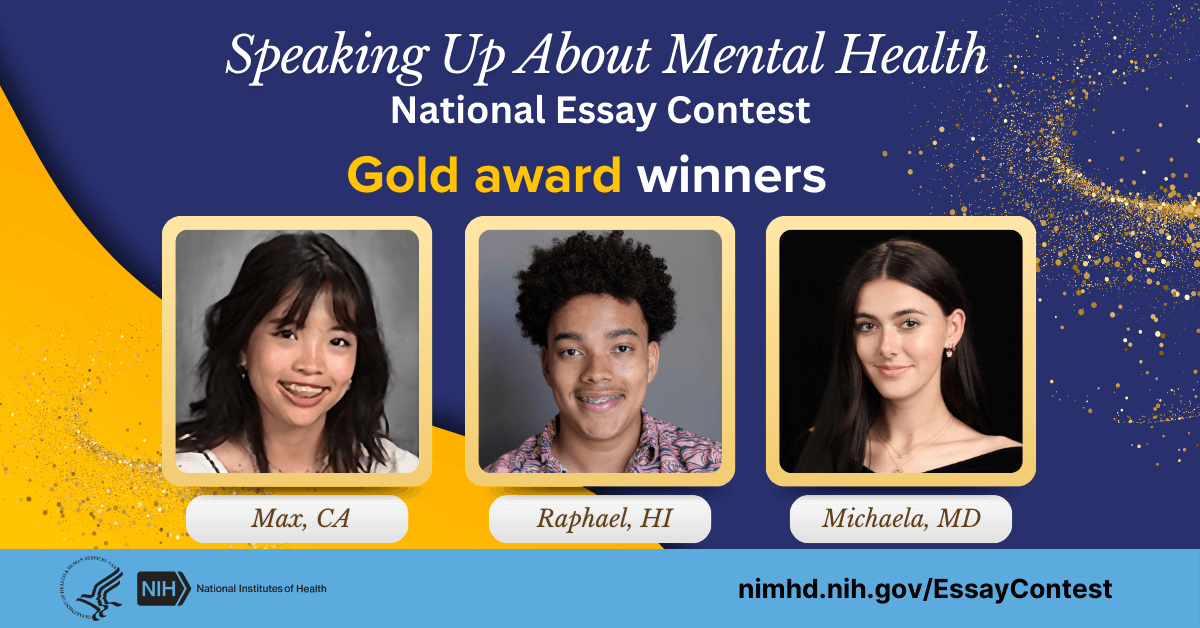
Gold Winners
Tenacity through tumultuousness.
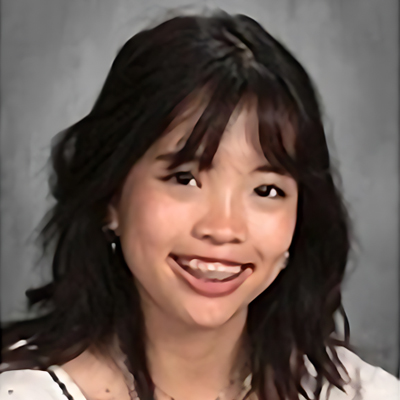
Max, California
In this essay I recount my past: from hospitalizations to advocacy, mental health is not something we just have to "survive" with but rather a tool we leverage to help others thrive, an unabashed reminder against preconceived stigma. As Kelly Clarkson once sang, "'What doesn't kill you makes you stronger,'" and mental health has not only made me more resilient but my community as well.
Exposing the Impact of Social Media on Teenage Mental Health: A Journey of Self-Discovery
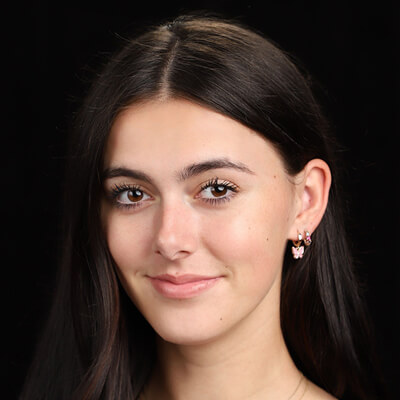
Michaela, Maryland
This essay explores the detrimental effects of social media on teenage mental health, tracing a personal journey from immersion in virtual reality to self-discovery. The author, grappling with the toxic influences of platforms like Instagram and Snapchat, ultimately breaks free from the cycle of comparison and seeks to raise awareness and implement measures to combat social media addiction among youth, advocating for education, support, and regulation.
Let's CHAT: Mental Health Impact on Teens Living With Speech Challenges
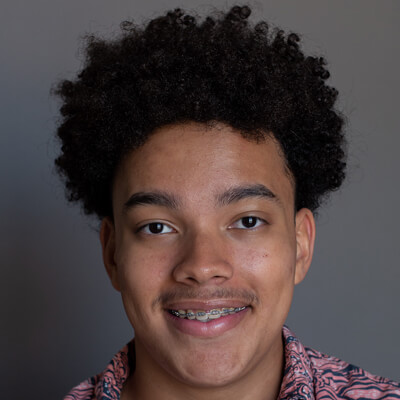
Raphael, Hawaii
Navigating through a fluid world as a young stutterer tests one's mental stability on a regular basis. This essay highlights the link between teens with speech challenges and mental health while fostering a communal environment of normalcy for those with speech differences.
Silver Winners
Embracing authenticity.

Aditi, California
Self respect is often overshadowed by societal expectations, but in this essay, I aim to promote inclusivity and emphasize the significance of individuality. Through personal reflections and insights, I underscore the importance of awareness, destigmatizing mental health issues, and increasing access to mental health resources to foster a supportive and meaningful environment.
Change Our Approach: How Sports Can Play a Role in Mental Health
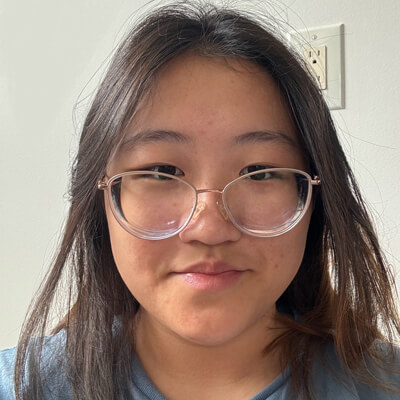
Anna, New York
Physical activity is an important health behavior that can affect many different aspects of physical health, but also mental health. In my essay, I describe how sports have impacted me and how having more open, informal team sports can benefit others.
The Roots Affect the Fruit: A Personal Journey of Trauma to Triumph
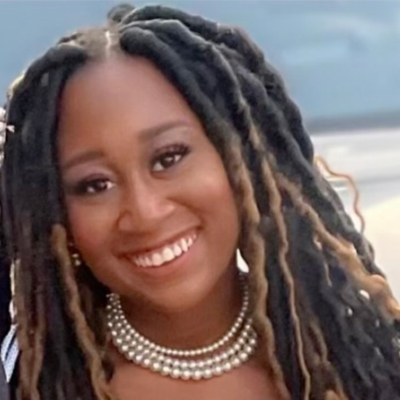
Ciniyah, Illinois
This essay addresses how generational trauma has negatively impacted the foundation of the Black family. By doing so, I examine the brokenness within my own family, the trauma my father has given me, and how poor experiences can make an individual even more powerful.
Behind a Perfect Life
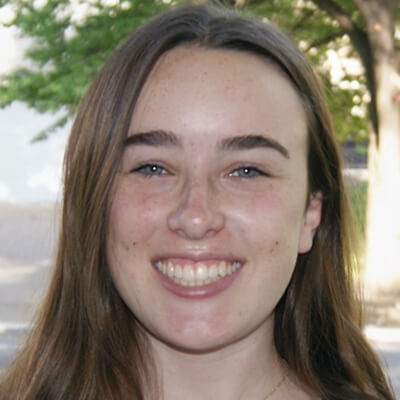
Kathleen, Maryland
It is important to remember that mental health disorders affect many people, but not everyone is open about their struggles. In my essay, I describe what schools can do to destigmatize mental health conditions and teach students how to reach out for help.
Learn to Live and Accept Your Journey
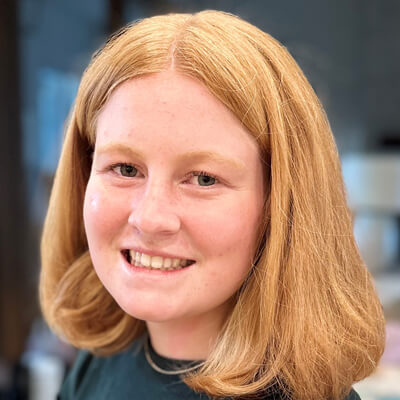
Paige, Texas
I have been battling my anxiety for as long as I can remember whether it was stress over a test, a nervous tick, or worry about my athletic performance. Getting help for my anxiety was the best decision my parents and I ever made because it helped take a massive burden off of me, so that I could go back to enjoying my everyday life.
Drowning in Plain Sight
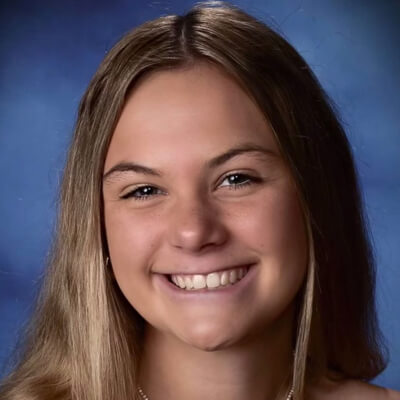
Rylie, Maryland
By sharing my journey, I hope to bring awareness to youth mental health and what it’s like to feel trapped in your thoughts. My hope by speaking up about mental health is to provide more mental health resources and reduce the stigma around mental health.
Bronze Winners
Normalize the care to destigmatize the conditions.
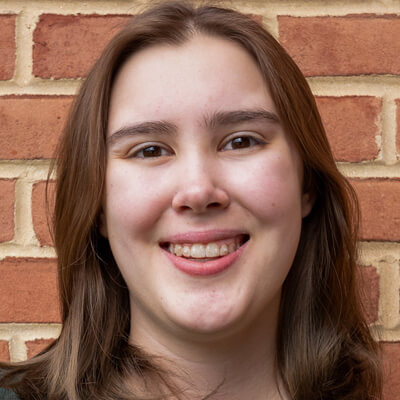
Dresden, Maryland
Destigmatizing mental health issues will only occur if the dialogue surrounding them departs from the current dramatization and glamourization that plagues online media. The first step in building a healthier societal relationship with mental health issues—especially among teens—is to normalize seeking treatment for them.
Keeping My Head Up: My Experience with Dad's Brain Cancer
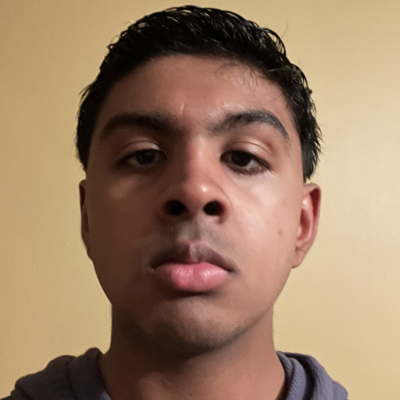
Gabriel, New Jersey
Last year, my father was diagnosed with terminal brain cancer, and I had sunken into a crippling, hopeless depression. This is my story on how changing my mindset led to a happier life for us all.
Access for Adolescent Athletes
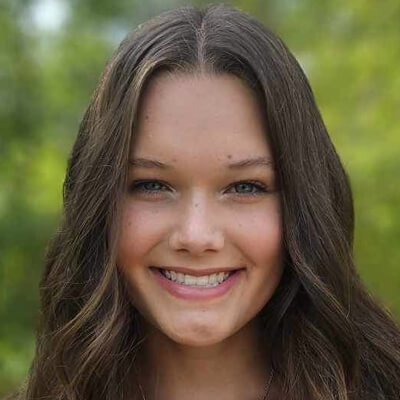
Hailey, Arkansas
I want to spread awareness about the importance of mental health awareness, especially regarding athletes. Mental health in athletes is typically unmentioned and disregarded, so I wrote this essay to highlight the significance on taking care of yourself.
Out in the Open: A Conversation About Mental Health
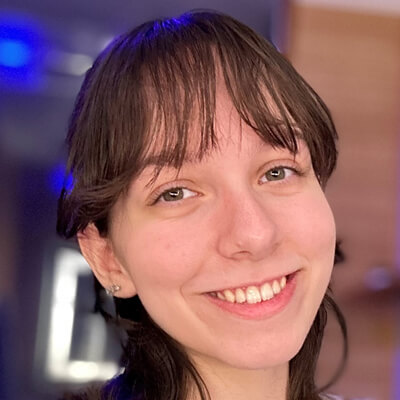
Iro, Pennsylvania
Blindness and negligence are the main reasons mental health is stigmatized, thus they should be eliminated with the aim of creating a safer environment for all students to express themselves freely. By addressing it openly and changing school policies, such as implementing anonymous support groups, mandatory mental health classes, and clubs that provide healthy coping mechanisms, we can reduce the negative perception and educate students and teachers alike on the subject.
A Weighted Wait
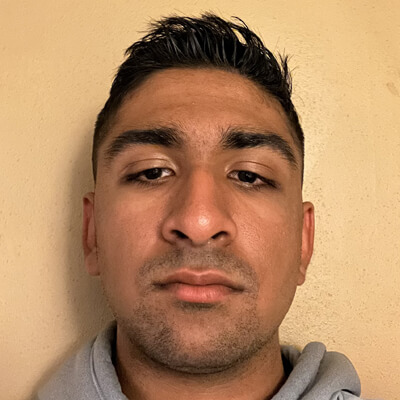
Jordan, New Jersey
When most people think of hospice, they only imagine patients who are physically ill, such as those with end-stage cancer, kidney failure, or a traumatic brain injury. However, loneliness within the hospice setting is a serious mental health concern as well, and it is imperative that we compassionately care for these patients in their final months so they may leave this earth in peace and with a sense of comfort and fulfillment.
Embracing Openness: Unveiling Silent Struggles Surrounding Mental Health
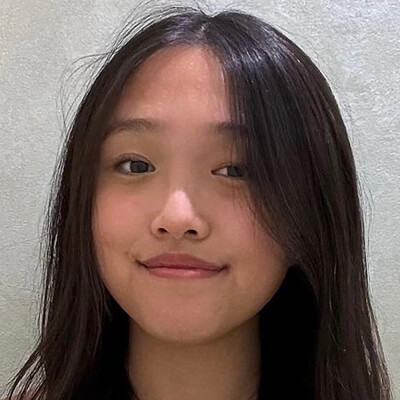
Kathryne, North Carolina
Individuals should never compromise their mental health for cultural expectations; my essay explores the intersection of mental health barriers and cultural norms, specifically highlighting the silent struggles faced by Asian American students. By advocating for accountability among educators and fostering diverse school environments, my solutions aim to empower students to seek support without feeling burdened by shame or cultural expectations.
Speaking Up for Change
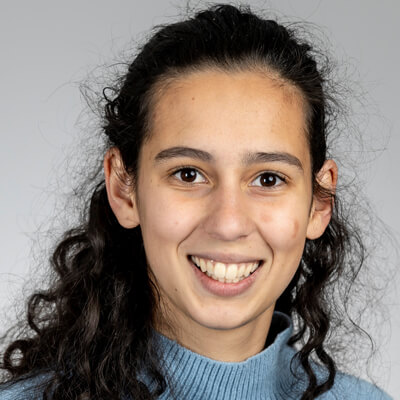
Maya, Maryland
Personal experience with the American mental health system has given me first hand evidence that something within needs to change. The magnitude of the issue including stigma and long wait times to see certified professionals is a system wide issue, leaving caring providers and patients alike struggling.
Embracing the Journey Towards Mental Health Acceptance
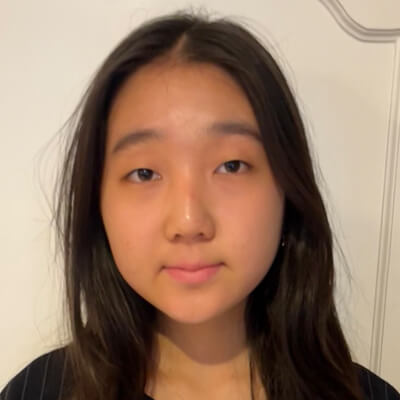
Rachel, California
When I watched my brother be silenced by the world around him, I felt the need to speak up against the stigmas that suppress the realities of mental health. Writing this essay allowed me to navigate through the often-neglected topic of youth mental illness and discover possible solutions with modern-day technological advancements.
Taking a Step Today, for a Better Tomorrow
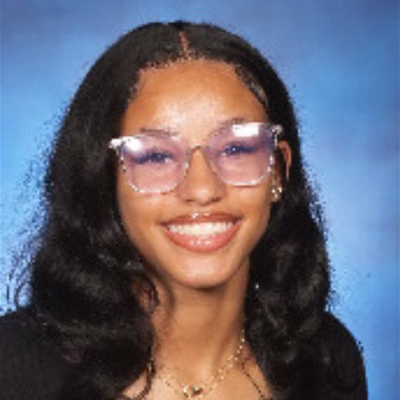
Savannah, New Jersey
My essay consists of informing people what can cause mental health problems and what contributing factors involve the rise of mental health. Also, contains information about how we can fix or lower mental health issues for teens and adults.
Honorable Mentions
Accountability for authority: the responsibilities of schools.

Agaana, Maryland
In discussing why schools need to address students' mental health issues, my essay considers how schools can influence students through academic pressures, social struggles, and management of time within and out of school. While alluding to a personal anecdote of generalized anxiety disorder, I also suggest courses of action that schools can take to mitigate the mental health issues that they contribute to.
Breaking the Silence
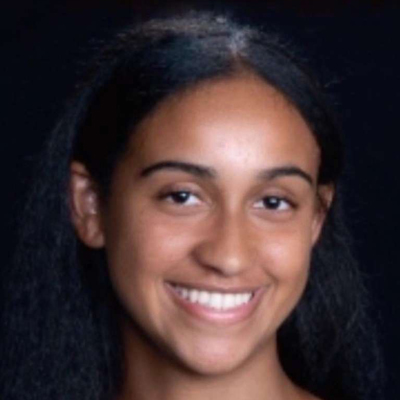
Gisele, Pennsylvania
A writing that delves into the crucial topic of dismantling mental health sigmas, ultimately providing valuable insights on how to overcome them. Additionally, this piece sheds light on the collective responsibility of society to foster inclusivity and a supportive environment for individuals facing these challenges.
Navigating Mental Illness in Teens
Jillian, Illinois
Mental health can be a difficult topic. This essay argues that normalizing these conversations can create a safer environment for children to express their feelings and gain mental health support.
How the Neglect of Mental Health Within Black Communities Causes Underlying Issues
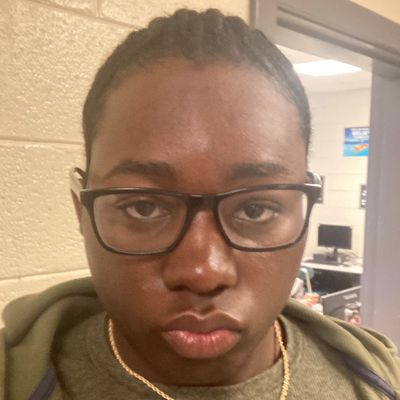
Kyle, North Carolina
My essay, (How the neglect of mental health within black communities causes underlying issues) details the relationship between African Americans and the U.S.A. health system, specifically its mental health system, and how stereotype as well as racial discrimination, caused black people to often turn to unlikely sources to release mental frustrations.
Social Media as a Possible Method to Reduce Mental Health Stigma
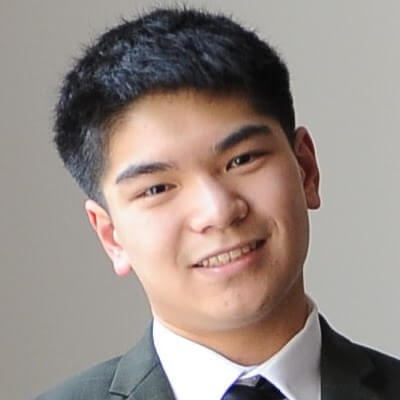
Mason, Maryland
This essay discusses sponsoring social media influencers to encourage them to open up about their mental health struggles because influencers have a huge effect on their audiences. It furthermore analyzes the possible risks, benefits, and specifics of implementing and utilizing this strategy.
Hope to Bridge the Gap
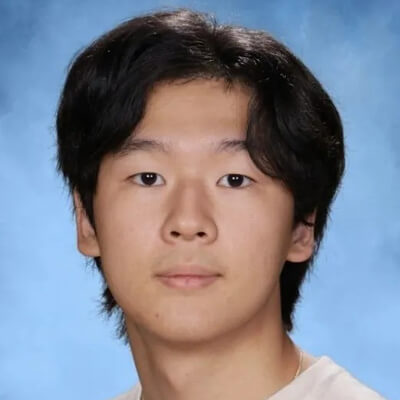
Minsung, Georgia
Mental health influences everyone in society in every unique context, no matter what your background or the hurdles you face. In my essay, I discuss my personal mental health experience as an Asian American and reveal the power of advocacy in breaking stigmas and fostering community support, inspiring change by highlighting the universal importance of mental well-being.
NIH recognizes these talented essay winners for their thoughtfulness and creativity in addressing youth mental health. These essays are written in the students' own words, are unedited, and do not necessarily represent the views of NIH, HHS, or the federal government.
Page published May 31, 2024
May 2024: NIH Announces Winners of High School Mental Health Essay Contest
Dec. 2023: High School Students Invited to Reflect on Mental Health Stigma in National Essay Contest
National Institute of Mental Health
National Institute on Minority Health and Health Disparities
Eunice Kennedy Shriver National Institute of Child Health and Human Development

Staying Connected
- Funding Opportunities
- News & Events
- HHS Vulnerability Disclosure
- Privacy/Disclaimer/Accessibility Policy
- Viewers & Players
Skip to Content
Waging Peace Project Essay Contest Winner Announced
The Center for Asian Studies and Partnership for International Strategies in Asia (PISA) joined Norlin Library and several departments on campus to host the exhibit, Waging Peace in Vietnam: U.S. Soldiers and Veterans Who Opposed the War . Curated by Ron Carver, the display of photographs, documents, and oral histories documented dissent within the United States active duty armed forces, among officers, and returning veterans, as well as their means of disseminating information to mobilize others. Launched on October 30, 2023, the first week included a series of events that engaged multiple units across campus including the College of Music, the English Department, the College of Media, Communication and Information, the History Department, the College of Arts and Sciences Honors Program, the Applied History Program, and the Center of the American West. The Waging Peace Project at CU Boulder was made possible by support from the Chino Cienega Foundation.
With film screenings, panel discussions, poetry readings, and lectures, the Waging Peace project amplified the message that the American War in Vietnam has had a legacy of baneful consequences that endure to this day. Recordings of most of the events can be found on the PISA page on the Center for Asian Studies website .
As a key feature of the project, students were invited to submit essays with their reflections on viewing the exhibit. Renowned photojournalist Nick Ut, whose photo of the so-called “Napalm girl” helped to move public opinion against the war, selected Ian Messa’s essay and Vietnam Veteran Curt Stocker presented the award on behalf of Veterans for Peace. Ian hails from Golden, Colorado. He is majoring in geography and pursuing an environment-society geography B.A. with hydrology and GIS certificates, as well as a civil engineering minor. Congratulations Ian!
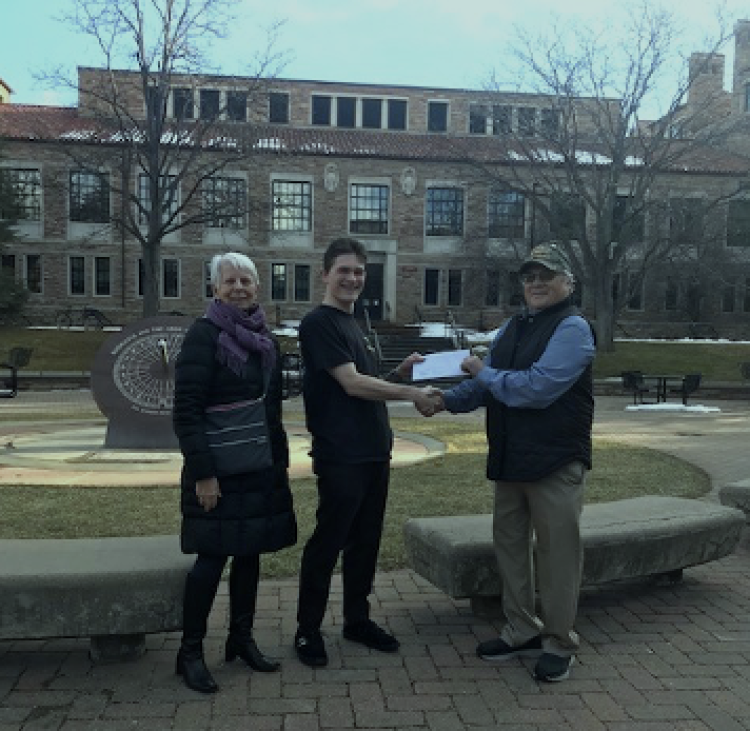
Curt Stocker, Vietnam veteran and member of Veterans for Peace presents a $500 check to Ian Messa, while Linda Yarr, director of PISA looks on.
Ian’s thoughtful essay, Waging Peace, empathically recalls his childhood as he reflects on the consequences of the American War in Vietnam as he viewed the exhibit. You can read his essay here:
Waging Peace
I’d never seen unexploded cluster bomb submunition before looking through Waging Peace in Vietnam . I thought it would be more hostile – silver-and-red rusted steel, maybe something bullet- shaped. Instead, I saw a photo of a dark-brown metal baseball with curious directional patterns cast into it.
When my brother and I were young, we would climb dead trees and swordfight with rusty steel fenceposts; we had a go-kart that was all too sparse and wobbly for its lawnmower engine. If we were to find one of these unexploded bombs on the ground, we would have made the same decision Hồ Văn Lai and his friends did – to play with the thing. With each throw, I bet we’d try to spin it the same direction the arrow-like things on its surface point.
It hurts to think about finding an object so strange and wondrous only to have it maim or kill you. It hurts more to think about the guilt and blame borne from those situations: Who lived and who died? Who found it on the ground? Whose idea it was to play with it at first – whose idea it was to play with it again on that day? And how hard would it be to remind yourself that Americans left it there; how would you cope with the fact that they won’t be held accountable because they’re long gone?
Across the library, covers from wartime magazines are spread across another black-papered posterboard. On an issue of FTA (“Fun Travel Adventure,” a stand-in for “Fuck the Army”), the soldiers at Iwo Jima raise a huge purple flower instead of the American flag. It’s hard to imagine producing an image like this as a soldier in Vietnam: Practically forced to knowingly kill innocent people, stuck with fear and protocol in an unfamiliar landscape for days on end, how did these soldiers return to base, meet at an anti-war coffee shop, and portray their hatred of the conflict in such a heartfelt way?
Waging Peace in Vietnam captures violent disjunctions. Kids play games with armed bombs; soldiers raise war-flowers on self-print magazines. Photos and media from the war hang in black and white, simple compared to the high-def colored pictures from decades after – survivors of cluster bombs and agent orange, volunteers cleaning the land, veterans standing stolid against their own memories of paralysis and misdeed. The war itself never ended: The U.S. military is gone, but it’s still tearing towns, families, and individuals apart with stray munitions, tainted memories, and violence against bodies and minds. That violence has only grown more difficult to trace.
What resonates with me most is the phrase “waging peace.” There are kids in the United States who play with syringes and firearms. There are police, soldiers, and security guards who feel helpless to do what they believe is right for fear of retribution, rejection, and ruin. People here, and around the world, are stuck in violence – born into it; forced into it; attracted to it until they see it, at which point they cannot turn back.
The violent scars of war loom so large in Vietnam, their tissue suffocating its inhabitants, that it is impossible to ignore them. Attaining peace is not an act of cessation or reflection, but of constant resistance against the tumorous spread of violence. It really isn’t something we “attain” at all; we need to constantly wage it with money, time, and passion – with everything we have.
- Spotlight All
- Spring 2021 Newsletter
- Spring 2020 Newsletter
- Spring 2019 Newsletter
- Spring 2018 Newsletter
- Spring 2017 Newsletter
- CAS E-News Newsletter
- Central Asia
- Southeast Asia
- Transnational/Comparative
- West Asia/Middle East
- Annual Themes
- Event Publications
- Past Events
- Share full article

Ibram X. Kendi Faces a Reckoning of His Own
In 2020, the author of “How to Be an Antiracist” galvanized Americans with his ideas. The past four years have tested them — and him.
Ibram X. Kendi, the founding director of the Boston University Center for Antiracist Research. Credit... Wayne Lawrence for The New York Times
Supported by

By Rachel Poser
Rachel Poser is an editor for the magazine. She spoke to Kendi over a period of several months and visited him at his research center in Boston.
- June 4, 2024
Ibram X. Kendi has a notebook that prompts him, on every other page, to write down “Things to be grateful for.” There are many things he might put under that heading. First and foremost, his wife and two daughters, and his health, having made it through Stage 4 colon cancer in his 30s — a diagnosis with a 12 percent survival rate. Tenure at Boston University, where Martin Luther King Jr. earned his doctorate in theology. A National Book Award, and a MacArthur “genius” grant for “transforming how many people understand, discuss and attempt to redress America’s longstanding racial challenges.” Then there were the millions of people who bought “How to Be an Antiracist,” the first of five of his books to take the No. 1 spot on the New York Times best-seller list. But he was particularly grateful to the readers who wrote to him to say his work changed them for the better.
Listen to this article, read by January LaVoy
These days, he could use the reminder. Four years have gone by since George Floyd was murdered on the pavement near Cup Foods in Minneapolis, sparking the racial “reckoning” that made Kendi a household name. Many people, Kendi among them, believe that reckoning is long over. State legislatures have pushed through harsh antiprotest measures . Conservative-led campaigns against teaching Black history and against diversity, equity and inclusion programs are underway. Last June, the Supreme Court struck down affirmative action in college admissions. And Donald Trump is once again the Republican nominee for president, promising to root out “the radical-left thugs that live like vermin within the confines of our country.”
Kendi has become a prime target of this backlash. Books of his have been banned from schools in some districts, and his name is a kind of profanity among conservatives who believe racism is mostly a problem of the past. Though legions of readers continue to celebrate Kendi as a courageous and groundbreaking thinker, for many others he has become a symbol of everything that’s wrong in racial discourse today. Even many allies in the fight for racial justice dismiss his brand of antiracism as unworkable, wrongheaded or counterproductive. “The vast majority of my critics,” Kendi told me last year, “either haven’t read my work or willfully misrepresent it.”
Criticism of Kendi only grew in September, when he made the “painful decision” to lay off more than half the staff of the research center he runs at Boston University. The Center for Antiracist Research, which Kendi founded during the 2020 protests to tackle “seemingly intractable problems of racial inequity and injustice,” raised an enormous sum of $55 million, and the news of its downsizing led to a storm of questions. False rumors began circulating that Kendi had stolen funds, and the university announced it would investigate after former employees accused him of mismanagement and secrecy.
The controversy quickly ballooned into a national news story, fueled in large part by right-wing media, which was all too happy to speculate about “missing funds” and condemn Kendi — and the broader racial-justice movement — as a fraud. On Fox News, the conservative activist Christopher Rufo told the host John Roberts that the center’s “failure” was “poetic justice.” “This is a symbol of where we have come since 2020 and why that movement is really floundering today,” he said. In early October, a podcast affiliated with the Manhattan Institute, the conservative think tank where Rufo works, jubilantly released an episode titled “The End of Ibram X. Kendi?”
‘I don’t know of anybody more ill suited for fame than Ibram Kendi.’
In December, I met Kendi at the Center for Antiracist Research, which was by then mostly empty, though I caught signs of its former life: Space heaters sat idly under desks, and Post-it notes lingered around the edges of unplugged monitors. On the frame of one cleared-out cubicle, a sticker in the shape of Earth read “Be the change.” Kendi welcomed me into his office in a pink shirt and a periwinkle blazer with a handkerchief tucked neatly in its pocket. He was calm on the surface, but he seemed to me, as he often did during the conversations we’d had since the layoffs, to be holding himself taut, like a tensile substance under enormous strain. The furor over the center, he said, was a measure of how desperate many people were to damage his reputation: “If this had happened at another center, it would either not have been a story or a one-day story.”
In “How to Be an Antiracist,” his best-known book, Kendi challenges readers to evaluate themselves by their racial impact, by whether their actions advance or impede the cause of racial equality. “There is no neutrality in the racial struggle,” he writes. “The question for each of us is: What side of history will we stand on?” This question evinces Kendi’s confidence that ideas and policies can be dependably sorted into one of two categories: racist or antiracist.
Kendi is a vegan, a tall man with a gentle, serious nature. “He’ll laugh at a joke — he’ll never crack one,” Kellie Carter Jackson, the chair of the Africana studies department at Wellesley and someone who has known Kendi for years, told me. He considers himself an “introvert and loner” who was chased down by the spotlight and is now caught in its glare. “I don’t know of anybody more ill suited for fame than Ibram Kendi,” said Stefan Bradley, a longtime friend and professor of Black studies at Amherst. There is a corniness to Kendi that’s endearing, like his use of the gratitude notebook — a thick, pastel-colored pad with gold spiral binding — or the fact that his phone email signature is “Sent from Typoville aka my iPhone.” Though he is always soft-spoken, volume sometimes seems to be a gauge of how comfortable he feels. The first time I met him in person, he greeted me so quietly that I worried my recorder wouldn’t pick up his voice.
Kendi had hired a pair of crisis-P.R. consultants to help him manage the fallout from the layoffs, a controversy that he believed had fed into dangerous, racist stories about Black leaders, and about him in particular. In the fun-house mirror of conservative media, Kendi has long loomed as an antiwhite extremist trying to get rich by sowing racial division. Kendi told me he received regular threats; he allowed me to come to the center only on the condition that I not reveal its location. “When it comes to the white supremacists who are the greatest domestic terrorist threat of our time, I am one of their chief enemies,” he told me.
Boston University had recently released the results of its audit, which found “no issues” with how the center’s finances were handled. The center’s problem, Kendi told me, was more banal: Most of its money was in its endowment or restricted to specific uses, and after the high of 2020, donations had crashed. “At our current rate, we were going to run out in two years,” he said. “That was what ultimately led us to feel like we needed to make a major change.” The center’s new model would fund nine-month academic fellowships rather than a large full-time staff. Though inquiries into the center’s grant-management practices and workplace culture were continuing, Kendi was confident that they would absolve him, too. In the media, he’d dismissed the complaints about his leadership as “unfair,” “unfounded,” “vague,” “meanspirited” and an attempt to “settle old scores.”
In the fall, when I began talking to former employees and faculty — most of whom asked for anonymity because they remain at Boston University or signed severance agreements that included nondisparagement language — it was clear that many of them felt caught in a bind. They could already see that the story of the center’s dysfunction was being used to undermine the racial-justice movement, but they were frustrated to watch Kendi play down the problems and cast their concerns as spiteful or even racist. They felt that what they experienced at the center was now playing out in public: Kendi’s tendency to see their constructive feedback as hostile. “He doesn’t trust anybody,” one person told me. “He doesn’t let anyone in.”
To Kendi, attacks from those who claim to be allies, like attacks from political enemies, are to be expected. In his books, Kendi argues that history is not an arc bending toward justice but a war of “dueling” forces — racist and antiracist — that each escalate their response when the other advances. In the years since 2020, he believes, the country has entered a predictable period of retrenchment, when the force of racism is ascendant and the racial progress of the last several decades is under threat. To defend antiracism, to defend himself, he would simply have to fight harder.
Not so long ago, Kendi thought he saw a new world coming into being. “We are living in the midst of an antiracist revolution,” he wrote in September 2020 in an Atlantic cover story headlined, “Is This the Beginning of the End for American Racism?” Nearly 20 percent of Americans were saying that “race relations” was the most urgent problem facing the nation — more than at any point since 1968 — and many of them were turning to Kendi to figure out what to do about it. They were buying his memoir and manifesto, “How to Be an Antiracist,” much of which he wrote while undergoing chemotherapy. “This was perhaps the last thing he was going to write,” Chris Jackson, Kendi’s editor, told me. “There was no cynicism in the writing of it.” (Jackson was the editor of a 2021 book based on The 1619 Project, which originated in this magazine in 2019 ; Kendi contributed a chapter to that book.)

Kendi confesses in the introduction that he “used to be racist most of the time.” The year 1994, when he turned 12, marked three decades since the United States outlawed discrimination on the basis of race. Then why, Kendi wondered as an adolescent, were so many Black people out of work, impoverished or incarcerated? The problem, he concluded, must be Black people themselves. Not Black people like his parents, God-loving professionals who had saved enough to buy a home in Jamaica, Queens, and who never let their two sons forget the importance of education and hard work. But they were the exception. In high school, Kendi competed in an oratory contest in which he gave voice to many of the anti-Black stereotypes circulating in the ’90s — that Black youths were violent, unstudious, unmotivated. “They think it’s OK to be the most feared in our society,” he proclaimed. “They think it’s OK not to think!” Kendi also turned these ideas on himself, believing that he was a “subpar student” because of his race.
Kendi’s mind began to change when he arrived on the campus of Florida A&M, one of the largest historically Black universities in the country, in the fall of 2000 to study sports journalism. “I had never seen so many Black people together with positive motives,” he wrote at the time. Kendi was disengaged for most of high school, as concerned with his clothes as his grades. His friends at the university teased him for joining a modeling troupe and preening before parties, particularly because once he got to them he was too shy to talk to anyone. “He would come out, and you could smell the cologne from down the hall,” Grady Tripp, Kendi’s housemate, told me. But experimenting with his style, for Kendi, was part of trying on new ideas. For a while, he wore honey-colored contact lenses that turned his irises an off-putting shade of orange; he got rid of them once he decided they were a rejection of blackness, like Malcolm X’s straightening his hair with lye.
Over long hours spent reading alone in the library, Kendi found his way to some unlikely conclusions. In “How to Be an Antiracist,” he describes bursting into his housemate’s room to declare that he had “figured white people out.” “They are aliens,” he said. Kendi had gone searching for answers in conspiracy theories and Nation of Islam theology that cast whites as a “devil race” bred by an evil Black scientist to conquer the planet. “Europeans are simply a different breed of human,” he wrote in a column for the student newspaper in 2003. They are “socialized to be aggressive” and have used “the AIDS virus and cloning” to dominate the world’s peoples. Recently, the column has circulated on right-wing social media as evidence of Kendi’s antiwhite extremism, which frustrates him because it’s in his own memoir as an example of just how lost he had become.
Kendi went on to earn a Ph.D. in African American studies from Temple University. The founder of his department was Molefi Kete Asante, an Afrocentrist who has called on the descendants of enslaved people to embrace traditional African dress, languages and religions. Kendi eventually changed his middle name to Xolani, meaning “peace” in Zulu; at their wedding, he and his wife, Sadiqa, adopted the last name Kendi, meaning “loved one” in Meru. Kendi has called Asante “profoundly antiracist,” but Kendi remained an idiosyncratic thinker who did not consider himself a part of just one scholarly tradition; he knew early on that he wanted to write for the public. In a 2019 interview, when asked about his intellectual lineage, Kendi named W.E.B. Du Bois, Ida B. Wells and Malcolm X.
Kendi became part of a cohort of Black writers, among them Nikole Hannah-Jones and Ta-Nehisi Coates, who, through the sunset of the Obama presidency and the red dawn of the MAGA movement, argued that anti-Blackness remains a major force shaping American politics. They helped popularize the longstanding idea that racism in the United States is systemic — that the country’s laws and institutions perpetuate Black disadvantage despite a pledge of equal treatment. The Civil Rights Act of 1964 ended de jure white supremacy, but President Lyndon B. Johnson, who signed it into law, acknowledged that it wouldn’t uproot a racial caste system grown over centuries.
“The next and the more profound stage of the battle for civil rights,” he said, would be to achieve “not just equality as a right and a theory but equality as a fact.” Kendi and others wrote bracingly about the failure of that promise. Far from economic redress, Black Americans were met with continued discrimination in every realm of life, while being told the country was now “colorblind.” Kendi and others argued that remedying the impact of hundreds of years of subjugation would require policies that recognize, rather than ignore, that legacy, such as affirmative action and reparations.
‘The vast majority of my critics either haven’t read my work or willfully misrepresent it.’
Far too many Americans, Kendi felt, still thought of racism as conscious prejudice, so conversations got stuck in cul-de-sacs of denial, in which people protested that they were “not racist” because they harbored no anti-Black animus. To convey this, he landed on the binary that would become his most famous and perhaps most controversial idea. “There is no such thing as a not-racist idea” or a “race-neutral policy,” he wrote in “How to Be an Antiracist,” published in 2019. “The opposite of ‘racist’ isn’t ‘not racist.’ It is ‘antiracist.’”
Black activists have long used the word “antiracist” to describe active resistance to white supremacy, but “How to Be an Antiracist” catapulted the term into the American lexicon, in much the same way that Sheryl Sandberg turned “Lean In” into a mantra. After George Floyd’s death, the book sold out on Amazon, which was “unheard-of,” Kendi said. Media coverage of Kendi in those days made him sound nearly superhuman. In a GQ profile, for example, the novelist ZZ Packer describes Kendi as a “preternaturally wise” Buddha-like figure, “the antiracist guru of our time” with a “Jedi-like prowess for recognizing and neutralizing the racism pervading our society.”
During the summer of 2020, Kendi sometimes appeared onstage or onscreen alongside Robin DiAngelo, the educator whose book “White Fragility” was also a No. 1 best seller. Kendi and DiAngelo write less about the workings of systemic racism than the ideas and psychological defenses that cause people to deny their complicity in it. They share a belief in what Kendi calls “individual transformation for societal transformation.” When Kendi took over Selena Gomez’s Instagram, for example, he urged her 180 million followers to “1. Acknowledge your racism,” “2. Confess your racist ideas” and “3. Define racism and antiracism.” Then they would be ready for Steps 4 and 5, identifying and working to change racist policies.
Kendi and DiAngelo’s talk of confession — antiracism as a kind of conversion experience — inspired many people and disturbed others. By focusing so much on personal growth, critics said, they made it easy for self-help to take the place of organizing, for a conflict over the policing of Black communities, and by extension their material conditions, to become a fight not over policy but over etiquette — which words to use, whether to say “Black Lives Matter” or “All Lives Matter.” Many allies felt that Kendi and DiAngelo were merely helping white people alleviate their guilt.
They also questioned Kendi’s willingness to turn his philosophy into a brand. Following the success of “How to Be an Antiracist,” he released a deck of “antiracist” conversation-starter cards, an “antiracist” journal with prompts for self-reflection and a children’s book, “Antiracist Baby.” Christine Platt, an author and advocate who worked with Kendi at American University, recently co-wrote a novel that features a Kendi-like figure — a “soft-spoken” author named Dr. Braxton Walsh Jr., whose book “Woke Yet?” becomes a viral phenomenon. “White folks post about it on social media all the time,” rants De’Andrea, one of the main characters. “Wake up and get your copy today! Only nineteen ninety-nine plus shipping and handling.”
Those who thought of him as a self-help guru, Kendi felt, simply hadn’t read his work. Like most scholars of race, Kendi believes that Blackness is a fiction born of colonial powers’ self-interest, not just ignorance or hate, meaning that combating racism today requires upending the economic and political structures that propagate it. But Kendi doesn’t like the term “systemic racism” because it turns racism into a “hidden and unknowable” force for which there’s no one to blame, so he prefers to talk about “racist policies.”
In The Atlantic, he warned against the country going down a path of symbolic change where “monuments to racism are dismantled, but Americans shrink from the awesome task of reshaping the country with antiracist policies,” like Medicare for All, need-based school funding and reparations. Changing policy was exactly what he aimed to do at Boston University. During the protests, in the summer of 2020, the university named Kendi the Andrew W. Mellon professor of the humanities, a chair previously held by the Nobel Peace Prize winner Elie Wiesel, and announced the creation of a center on campus to put his ideas into action. Donations came pouring in, led by an anonymous $25 million gift and a $10 million gift from the Twitter founder Jack Dorsey, which the provost said would give Kendi “the resources to launch the center like a rocket ship.”
Kendi started the center from his home in Boston, while Sadiqa, a pediatric E.R. doctor, came and went from the hospital in full protective gear. Kendi ran a research center as part of his old job at American University, but he felt unable to make a meaningful impact because the resources were modest and he was diagnosed with cancer just four months after its founding. Now, granted tens of millions of dollars to enact his most ambitious ideas, Kendi was determined to create an organization that could be a real engine of progress. “We’ve got to build an infrastructure to match what the right has created,” he later told a co-worker. “We’ve got to build something equally powerful.”
Kendi’s two centers were part of a wave of racial-justice spaces being founded at universities, like the Thurgood Marshall Civil Rights Center at Howard or the Ida B. Wells Just Data Lab at Princeton, that pledged to work in partnership with activists and community groups to achieve social change. Kendi envisioned an organization that supported people of color in campaigning for policies that would concretely improve their lives.
To reflect that mission, he designed a structure with four “pillars” or offices: Research, Policy, Narrative and Advocacy. He recruited data scientists, policy analysts, organizers and educators and brought in faculty members working on race from across the university. They set up a model-legislation unit, which would draft sample bills and public-comment notes; an amicus-brief practice, which would target court cases in which race was being overlooked as an issue; and a grant process to fund research on racism by interdisciplinary teams elsewhere at the university, among other programs. Kendi also struck up a partnership with The Boston Globe to revive The Emancipator, a storied abolitionist newspaper. “It was a really exciting time,” he told me.
That summer, however, Kendi found himself on the defensive beyond Boston as Republican book-banning campaigns revved up. On Fox News, Tucker Carlson denounced “How to Be an Antiracist” as “poisonous,” plucking out Kendi’s summary of the case for race-conscious policymaking, which sounded particularly maladroit when taken out of context: “ The only remedy to racist discrimination is antiracist discrimination ,” Carlson read in mock disbelief. “In other words, his book against racism promotes racism.” This was around the same time that Rufo, the conservative activist, started to position Kendi as a leading proponent of critical race theory, a school of thought, Rufo told The New Yorker, that he discovered by hunting through the footnotes of “How to Be an Antiracist.”
Critical race theorists were a group of legal scholars in the 1970s and ’80s who documented ways that the American legal framework of racial equality was nevertheless producing unequal treatment. They elaborated the idea of systemic racism and the critique of “colorblindness” that inform much of the writing of Kendi’s cohort. Rufo wrote on Twitter that his goal was to change the meaning of the term “critical race theory” — to “turn it toxic” by putting “all of the various cultural insanities under that brand category.” In his attacks on Kendi, Rufo also amplified the left’s critique of Kendi’s corporate-friendliness, caricaturing Kendi as a grifter out to enrich himself by raking in speaking fees. The number of threatening messages Kendi received began to rise. “I don’t feel safe anywhere,” Kendi later told a colleague. “I’m constantly looking over my shoulder.”
By the time the academic year began, in the fall of 2021, Kendi decided to take extraordinary measures. Before the center began in-person work that September, Kendi sent the staff an email about “security protocols,” instructing them to conceal the location of the center even from other Boston University faculty members and students. “It is critical to not share the address of the center with anyone or bring anyone to the center,” Kendi wrote. The email included a mock script to be used in the event of an inquiry about the center’s location, which ended abruptly with, “I gotta go.”
Though such precautions felt necessary to Kendi, they were met with incredulity and frustration by some employees who were starting to question his leadership. Problems emerged within the first six months, according to more than a dozen staff and faculty members I interviewed. Some told me they had gone to the center because they considered Kendi a visionary; others had reservations about or flat-out disagreements with his work but believed he had brought much-needed attention to issues they cared about. They would be able to find common ground, they thought. They were ready for some chaos as they tried to spin up a new organization remotely, but they quickly ran into difficulty as they tried to execute some of Kendi’s plans.
Kendi emphasizes in his books that policies alone are the cause of racial disparities today. In “Stamped From the Beginning,” his 2016 history of anti-Black ideas from the 15th century to the Obama presidency — which won the National Book Award and was recently made into an Oscar-nominated Netflix documentary — Kendi writes that blaming Black people for their own oppression, by implying that Black people or Black culture are inferior or pathological, was one of the oldest cons in America. He had witnessed it again during the early days of the pandemic, when the numbers suggested that Black people were dying from Covid faster than every racial group save Native Americans. Some pundits speculated about the “soul food” diet or posited that Black communities weren’t taking the virus seriously, even though a Pew survey found that Black respondents were most likely to view the coronavirus as a major threat.
Kendi wanted the center to build “the nation’s largest online collection” of racial data to track disparities like this one and do analytical work to understand each policy responsible. In the case of Covid, for example, Black Americans are disproportionately likely to work in low-income essential jobs, to live in crowded conditions and to lack access to high-quality insurance or medical care. The center might research these conditions and propose targeted interventions, like changes to Medicaid coverage, or more transformative measures, like a universal basic income. One faculty member involved told me that she was “initially incredibly enthusiastic” about the idea. “It seemed like an opportunity to do rigorous, well-funded social-science research that would be aimed at real policy change on issues that I cared about,” she told me.
Like Kendi, his staff believed that historical oppression and ongoing discrimination explained why Black Americans fared comparatively poorly on so many measures of well-being, from education to wealth to longevity, and that centuries of injustice demanded a sweeping policy response to remedy. But understanding that past and present racism is the underlying cause of Black disadvantage is different from the work of assessing its role in any single policy, let alone figuring out how to change the policy to eliminate it. That takes careful analysis. “You have to have specificity,” the faculty member said, “or you can’t measure.”
Kendi pushed back at staff members who argued that the center should constrain its focus. There were plenty of academic centers and researchers that tracked data on racial disparities in one policy area or another, he said; he wanted to convene that pre-existing data, bringing it together in one place for easy access by the public. In a 2022 meeting, when the team tried to get a better sense of his vision, Kendi told them that he wanted a guy at a barbershop or a bar to be able to “pull up the numbers.” To many employees with data or policy backgrounds, what Kendi wanted didn’t seem feasible; at worst, they thought, it risked simply replicating others’ work or creating a mess of sloppily merged data, connected to too many policies for their small team to track rigorously. In the midst of the pandemic, the center struggled to hire a director of research who might have been able to mediate the dispute.
In November, a confidential complaint was filed with the university administration raising concerns about Kendi’s leadership. The anonymous employee told a university compliance officer that Kendi ran the center with “hypercontrol” and created an environment of “silence and secrecy” that was causing low morale and high turnover, claiming that “when Dr. Kendi is questioned, the narrative becomes that the employee must be the one with the ‘problem.’” The employee warned the university that the situation “is potentially going to blow up.”
One of Kendi’s refrains is that being antiracist demands self-criticism. “If I share an idea that people don’t understand, I’m to blame,” he told an interviewer in 2019. “I’m always to blame.” Kendi told me that his most productive conversations with critics of his ideas often happened in private, including one with a prominent Black thinker who inspired him to make a change in the revised edition of “How to Be an Antiracist.” “This person talked about how the goal should not just be equity,” Kendi said. “The goal should not be the same percentage of Black people being killed by police as white people. The goal should be no one being killed by police.” But some Black scholars, as the right-wing backlash strengthened, debated whether to make their criticisms in public. The philosopher Charles Mills, after listening to a graduate-student presentation about Kendi and DiAngelo at a conference in 2021, asked the presenter: “Are their views now sufficiently influential, or perhaps sufficiently harmful, that we should make them a part of the target?”
Kendi was frustrated to be constantly lumped in with DiAngelo, whose ideas diverge from his in important ways. DiAngelo considers “white identity” to be “inherently racist,” while Kendi argues that anyone, including Black people, can be racist or antiracist. That puts him at odds with an understanding — common in the academy and the racial-justice movement — that Black people can’t be racist because racism is a system of power relations, and that Black people as a group don’t have the structural means to enforce their prejudice; this notion is often phrased as a formula, that racism is “prejudice plus power.”
Kendi thinks of “racist” not as a pejorative but as a simple word of description. His reigning metaphor is the sticker. Racist and antiracist are “peelable name tags,” Kendi writes; they describe not who we are but who we are being in any particular moment. He says he opposes the censoriousness that has become the sharp edge of identity politics, because he doesn’t regard shame as a useful social tool. But he has no intention of taking the moral sting out of “racist” completely. “I wouldn’t say that a person is not being condemned when they’re being called a racist,” he told Ezra Klein in a 2019 interview.
Rather than replacing one definition of racism with another, Kendi is really joining two senses into one. For much of the 20th century, the white mainstream considered racism a personal moral issue, while Black civil rights activists, among others, argued that it’s also structural and systemic. In his definition, Kendi aims to connect the individual to the system. A “racist,” he writes, is “one who is expressing an idea of racial hierarchy, or through actions or inaction is supporting a policy that leads to racial inequity or injustice.”
Kendi’s focus on outcomes is not new. For decades, civil rights activists have brought lawsuits based on the legal theory of “disparate impact,” which holds that unequal outcomes prove that certain practices (by, for example, an employer or a landlord) are racially discriminatory, without evidence of malicious intent. Kendi’s definition urges us to perform this sort of disparate-impact analysis all the time. In Politico in 2020, Kendi proposed the creation of a federal agency that would clear every new policy — local, state or federal — to ensure that it wouldn’t increase racial disparities. But as his team at the center knew well, policies can have complicated effects. Let’s say that a local environmental policy would improve the air quality in Black neighborhoods near factories but would also lead to hundreds of lost jobs and worsen the area’s racial wealth gap. Should it be cleared? Is such a policy racist or antiracist?
The question is made even trickier by the fact that the racial impact of many policies might not become clear until years later. The legacy of desegregation, for example, shows that even a profoundly antiracist policy can be turned against itself in its implementation. This is what the term “systemic racism” captures that can be lost in Kendi’s translation of “racist policies.”
In “Stamped From the Beginning,” Kendi writes that “racist policy is the cause of racial disparities in this country and the world at large.” Mary Pattillo, a sociologist at Northwestern, told me that Kendi’s focus on race didn’t fully capture the complexity of social life — the roles of class, culture, religion, community. “No one variable alone explains anything ,” she said. But she thought there was value in simplifying. She understood Kendi not as an official making policy but as a thought leader making a “defensible, succinct provocation.” “We live in a country whose ideology is very individualistic, so the standard response to any failure is individual blame,” she said. “Those of us who do recognize the importance of policies, laws and so on have to always push so hard against that that we have to make statements like the one that Kendi is making.”
I came to think, after months of talking to Kendi, that this was the key to understanding him — to remember that he is trying to push so hard against that . To shove back the anti-Black stereotypes he documented in “Stamped From the Beginning,” the racist ideas that poisoned his own mind and sense of self-worth. His aim, at every turn, is to blame the policies that create unequal conditions and not the people enduring them. But Kendi is so consumed by combating the racist notion of Black inferiority that some of what he says in response is overstated, circular or uncareful, creating an easy target for his critics and discomfiting his allies. Conservatives were far from the only ones alarmed, for example, by his proposal for a constitutional amendment to appoint a panel of racism “experts” with the power to discipline public officials for “racist ideas.” (Kendi told me he modeled this proposal on European countries like Germany, where the bar for hate speech is much lower.)
Some of Kendi’s ideas are softer than they appear at first. Kendi told me that people who believe that his binary applies to “everything” are misreading him. Though he writes that “there is no such thing as a not-racist idea, only racist ideas and antiracist ideas,” he says he never meant that sentence to apply to the whole universe of ideas, only to ideas about race. When I asked him whether the environmental policy above would be racist or antiracist based on his definition, he qualified that “policies can be like people, both racist and antiracist,” and went on: “By improving the air quality in Black neighborhoods near factories, the policy is being antiracist. By exacerbating the area’s racial wealth gap, the policy is being racist.” Many of his critics might find this a more reasonable position, but it also leads to a question about how useful or powerful a dichotomy it is in the end.
Kendi wanted to remain open to criticism, but so much of what he encountered was racist mockery, lies, professional jealousy, misreadings and threats. “I have thought many times about exiting my vocation as a scholar who studies racism,” he wrote in the revised edition of “How to Be an Antiracist.” “After the experience of the last three years, it does not feel safe for me to be publicly self-reflective or self-critical. It feels dangerous for me to be vulnerable.” Though he commits to doing so anyway, the onslaught brought on by celebrity seemed to cause Kendi’s introversion to harden into distrust. “Fame can be defeating and depleting,” Stefan Bradley, Kendi’s friend, told me. “Every word he puts into the atmosphere will be chopped up a hundred different ways, and that takes a toll on somebody’s mental health.” Bradley continued: “I think that if he were a lesser spirit, he would have been destroyed.”
That Kendi felt under siege became clear to Yanique Redwood when she started her job at the Center for Antiracist Research. Redwood had met Kendi once, in 2017, and she remembered him as soft-spoken but burning with big, exciting ideas. In the fall of 2021, when she interviewed to be the center’s executive director, Kendi told her he felt as though he was failing. Fund-raising while also running the center was too much for one person, and he wanted Redwood, a Caribbean American health and racial-equity researcher who had spent nearly a decade running a small foundation, to take over internal operations. Redwood was prepared to find some disorder, but the state of the center’s finances was a mess unlike any she had ever seen. “Nothing was in place,” she said. “It was unbelievable that an institution like that, with so much spotlight on it, just did not have systems. I understood why I was being brought in.”
Before starting, she conducted a round of entry interviews with faculty and staff members, and by her 27th and last conversation, she was exhausted from absorbing their frustration. “There’s something really wrong here,” she told Kendi. Much of the staff was relieved when Redwood was hired. There had been widespread confusion as employees were asked to do “damage control” by performing jobs for which they weren’t hired, or even qualified. “Everyone was overwhelmed,” Redwood told me. “There were too many promises being made to funders. Products were being promised that could never be delivered.”
Redwood designed a process to help get researchers going on pilot projects tracking disparities relating to felony murder, the health and social safety net, reparations and student-debt forgiveness. She wanted to share some takeaways from her round of entry interviews with the staff, in a tactful and encouraging way, to start the work of repairing the center’s culture, but Kendi worried that whatever she wrote might leak. A reporter from a conservative media outlet was reaching out to former employees, asking about problems at the center. “This media storm was coming,” Redwood told me. “It was brewing.”
Employees said Kendi’s fear of leaks slowed the work and created confusion and unease. The first time Rachael DeCruz, the head of the Advocacy office, asked Kendi about the center’s finances to help her budget, in 2021, he reacted “bizarrely,” she told me. “Why do you need that information?” he asked. (Kendi denies that this conversation took place. DeCruz says that after asking repeatedly, she received the information about six months later.) The threat of outside scrutiny exacerbated what employees described as Kendi’s tendency to withhold information to avoid interpersonal conflict. “He doesn’t understand people, how to nurture them, how to make them want to do their best work,” Redwood told me. “It’s not his strength, not even a little bit.”
During her entry interviews, Redwood asked each employee what the organization’s values were, and many of them responded by saying something along the lines of “I’ve been wondering that myself.” She encouraged Kendi to hold a retreat to talk through the mission as a group. Kendi was hesitant because he found work retreats “uncomfortable” — “sitting in a room with a large group of people all day long is exhausting for me,” he told me — but he committed to holding one anyway and solicited staff comments on a document he wrote laying out his theory of social change and the center’s role in it. “I was happy to receive all this great feedback,” he wrote to Redwood. “I think the changes will make the document much stronger and clearer.”
On a spring day in 2022, the staff met at a conference center a half-hour’s drive from campus. The day’s agenda, though couched in the gentle jargon of nonprofits, contained hints of the mood: The organizers on staff had scheduled time for an acknowledgment of the center’s growing pains, for a “healing justice moment” and for a period of “wicked questions” when concerns or challenges could be raised. At the start of the day, Naima Wong, an outside facilitator, encouraged the staff not to hold back. “We’re here to really get into this,” she said.
Late in the afternoon, when it was time to wrap up, the group assembled at tables arranged in a circle. Saida Grundy, a sociologist, was seated across from Kendi. She had never been on board with Kendi’s understanding of racism, subscribing instead to the “power plus prejudice” view. Grundy had forwarded Kendi’s email about security to colleagues with the note “The paranoia is INSANE.” “Ibram is so lily-livered he probably jumps when the biscuit tin pops,” she told me. Grundy was the one who, back in November, had made the anonymous complaint, in which some charges carried a hint of paranoia of her own, like the idea that Kendi “despises academia” and had “gotten satisfaction out of pulling academics out of their own research.” She had accused the center of being an exploitative workplace and, after having conflict with her supervisor, had already mostly stepped back from her role. Grundy had told the compliance office that the center might explode, and now she was ready to blow it up herself.
Her voice raised, Grundy laid out an indictment of the document Kendi wrote. “This is a mile wide and an inch deep,” she said. She argued that the center needed to be more specific about its goals; “fighting racism” was such a broad mission that it felt cynically strategic, allowing the center to take in money for all sorts of projects. “If there is a grant for antiracism on Jupiter, great,” she said. “We do extraterrestrial antiracism.” Grundy, unlike most of the staff, thought the center should become a resource for university faculty members and students; her parents were Black student activists in the 1970s, and she believed that real change starts where you are. “If you lined up 99 Black students at B.U.,” she said, “99 will tell you the center’s made no difference to their experience.”
When she finished speaking, the room was silent. Several people were crying. Dawna Johnson, the center’s financial director at the time, called it an “explosion.” “People didn’t know what to say after that,” she said. “It just left you so unhappy and uptight.” Kendi, his face inscrutable behind a Covid mask, said nothing, and the facilitator wrapped up the session. “Scholars who study the experience of Black leaders find that the No.1 racist challenge Black leaders face is contested authority, even from other Black leaders and staff,” he wrote to me later. I asked him what he remembered from that day. “It’s almost like trying to remember a day in which you were really happy, but then something horrible happened at the end,” he told me. “It’s hard to remember anything else other than that horrible thing.”
Grundy had admittedly come in hot, many staff members agreed, but it didn’t seem to matter how they couched their concerns. Employees continued to push to make sure that the center’s research projects were both rigorous and responsive to community needs, but the issues they raised in response to Kendi’s “theory of change” document never seemed to get fully resolved. “He’s communicating one thing,” one person said. “Behind the curtain, he’s behaving a very different kind of way.” Redwood and several others said that if someone was too persistent about a concern, Kendi would slow or stop his communication with that person. “If someone disagrees or someone is being vocal, you can’t just get rid of them,” she wanted to tell him. “Like, this is how you breed distrust.”
Redwood ultimately decided that Kendi wasn’t interested in building consensus around a shared mission. “Only he had the ideas,” she said. “We were there to execute on his ideas.” Redwood resigned in October 2022.
In a memo to The Times, Kendi disputed many of the staff’s recollections of his leadership. “This is not me, and anyone close to me, who has worked with me for a long time, knows that I’m open to constructive criticism as a writer and a thinker and a leader,” he wrote. Many progressive advocacy groups, Kendi pointed out, have been torn apart by internal clashes in recent years, conflicts that he said were driven by employees who “care more about performing their radicalism” than working to “improve the lives of everyday people.” “Former employees constantly deauthorized me as the director of the center — not because they were against hierarchy — but to assume authority for themselves,” he wrote.
Even before Redwood’s departure, Kendi told me, he realized the center was in financial trouble. He was far from the only nonprofit leader caught short as funding for racial-justice work collapsed after 2020. Funders that doused organizations with cash in the wake of George Floyd’s murder proved unwilling or unable to sustain their commitment, and layoffs were taking place across the sector, even at large nonprofits like the Chan-Zuckerberg Initiative. The center had gone from raising $40 million in 2020 to only a tenth of that — $420,000 — the next year.
In June 2023, after he went on parental leave, Kendi approached university leaders with the idea of switching to a fellowship model, which could adjust its number of awards to fluctuations in fund-raising. He told the staff only that he would be announcing some major changes when he returned from leave. Dawna Johnson, who succeeded Redwood as executive director, was left to manage a staff frustrated by being kept in the dark. “I think the staff thought I knew more than I actually did, as far as what the future of the center was,” she told me. “He’s like, Just don’t spend money, essentially, which is kind of difficult in an organization that needs to move forward.” (Kendi denies that he said anything like this to Johnson, who remains in her role today.)
Kendi spent the next three months taking care of his newborn daughter, Imara, and his wife, who was diagnosed with Stage 4 breast cancer while pregnant. In his absence, at another staff retreat, four employees stood up and spoke in turn about the problems at the center. Much of the staff had just learned that the center agreed to partner with the D.E.I. arm of the consulting company Deloitte, which does work for the police and prisons, on designing an antiracism training for corporate workplaces. “Why wasn’t this shared with the broader staff sooner, as a potential high-risk partnership that could impact the relationships we are forging with movement leaders?” one person said. “Why are we contemplating this partnership that arguably goes against our values?”
Kendi, who identifies as a police and prison abolitionist, suggested that donations from corporations could be seen as a “form of reparations,” and he stressed to me that the Deloitte agreement “allowed us to control the products from design to delivery.” He once again dismissed the critics at the retreat as “performative radicals” of the sort that have been “causing all kinds of havoc in Black-led social justice organizations for years, claiming that they are against hierarchy when they really are against being directed by a Black person.” He thought they were being hypocritical in objecting to the Deloitte partnership because they “do not object to personally having profiles on social media corporations that platform copaganda, or buying goods from retailers employing incarcerated labor in their supply chains, or using technology from corporations providing carceral states with technologies of surveillance.”
When I asked the employees about this, one of them called Kendi’s comments about hypocrisy a “deflection tactic.” She stressed that the staff was not making a demand but asking for an open dialogue — or at least a clearly articulated rationale — about decisions that affected them. His response fit a clear pattern, they thought, of believing that employees were trying to undermine him when they really just cared about the work. “I understand he’s coming from a place of trauma,” another told me. “He’s criticized unfairly and through a racist lens constantly. I do understand it. But then to distort that into an inability to receive feedback that’s going to ensure the success and usefulness of the center — that’s where it becomes a problem.”
In September, Kendi fired 19 of the center’s 36 employees in a series of Zoom meetings. Many told me they could understand the layoffs given the financial climate, but to change the model from an ambitious organization that had pledged to drive social change to one that handed out academic fellowships felt like a betrayal of the mission. The abruptness of the decision forced the staff to scramble to find other homes for projects, including a research program supporting Boston-area organizers on a campaign to challenge family policing in schools, for which they were in the midst of sensitive interviews with affected parents and caregivers. Breaking promises they’d made to grass-roots partners was what bothered her team most, said DeCruz, the head of the Advocacy office, because equitable and sustained relationships between communities and advocates build a strong network — a movement aligned on its goals. Pulling out damaged those relationships.
Though some staff members told me they appreciated Kendi — “My life forever, forever changed because I worked for someone who pushed me to envision what’s possible,” one said — many others had become darkly cynical about him. The most vocal among them was Grundy, who took to Twitter calling Kendi a “grifter” and fueling the rumor that he might have stolen funds. Redwood tried to have empathy. She imagined what it must be like to be constantly attacked — to have your intelligence insulted, your motives questioned. “I wonder if some of the secrecy and paranoid behavior came about as a result of that,” she told me. “I have no idea, and I had to just eventually stop trying to figure it out and just move on, because I couldn’t understand how the person I met when he was at American, when I sat down with him for lunch, the person who appeared to be so humble, so committed — and I still think he is committed — could be the person that I worked for. It is not something that I have ever been able to understand.”
Several people stressed to me that Kendi’s weaknesses as a leader were not as important as the larger forces that surrounded his leadership — the opportunism of white-led institutions, the boom and bust of trend-chasing nonprofit funding, the commodification of Black thought and activism. I asked Boston University to comment on a complaint I heard from the staff, that its administration had failed to provide adequate oversight. “Boston University provided significant financial and administrative support to Dr. Kendi and the center. Dr. Kendi did not always accept the support,” a spokesperson wrote. “In hindsight, and with the fuller knowledge of the organizational problems that arose, the university should have done more to insist on additional oversight.”
The spokesperson also said that the decision to end the center’s projects was Kendi’s choice. “Several different models were discussed with Dr. Kendi, including bringing many of the projects to completion over the next two years and lessening the impact on staff,” he wrote. “However, Dr. Kendi’s preference was to terminate the ongoing projects and ask the funders to repurpose the funds for his new endeavor.” (In a written response, Kendi accused the interim university administration of trying to undermine the center’s work. “The center has faced more oversight and scrutiny than every other center at B.U. from the Office of Research and this interim B.U. administration,” he wrote. “I’m disappointed that this interim B.U. administration is giving The Times a version of events that doesn’t reconcile with the facts.”)
The last time I saw Kendi in person was in January, when he came to New York to promote his newest book, a young readers’ adaptation of Zora Neale Hurston’s “Barracoon,” based on her 1927 interviews with Cudjo Lewis, one of the last survivors of the Middle Passage from Africa. That night, Kendi was doing an event at an independent bookstore in Brooklyn Heights, where the streets were salt-streaked after a light snowstorm and white string lights glowed on a tree outside. One of the three personal-security officers he brought with him — bearded Black men in black peacoats and dress pants, fitted with earpieces — was checking bags at the door.
Kendi was standing by a wall of books in a teal blazer, his pocket square in place. For a while, he said, he stopped doing many public events because of his security concerns, but he realized it had contributed to his feeling alienated and embattled. “Not doing live book signings prevented me from engaging with the people who were reading and appreciating my work,” he told me later. Going on tour again had “helped tremendously,” he said. But he didn’t want to be away from home long while Sadiqa was in treatment. “It’s incredibly difficult to witness someone you care about deeply facing so much pain and loss,” he said. “I’d much rather just be the one facing that pain.”
Boston University had cleared him and the center of grant mismanagement, but he was still waiting for Korn Ferry, the management consulting firm hired by the administration, to finish its culture inquiry, and he continued to attribute any dysfunction at the center to the hardships of the pandemic and employees who repeatedly contested his leadership. He was coordinating with the university on the center’s next phase, he said, but the work that felt most meaningful to him at the moment was “getting back to my roots as a writer.” He was at work on his next big project, a contemporary political history.
Kendi has spun out 13 books since “How to Be an Antiracist” in 2019, 10 of which are adaptations of his or others’ work for children. Since becoming a father, he told me, it has become even more important to him to reach young readers — particularly Black kids like him who may have internalized racist ideas about themselves. Earlier that day, Kendi spoke to 250 kids at a middle school elsewhere in Brooklyn, taking questions from a panel of seventh and eighth graders. “Barracoon” was the latest in a series of books he was adapting by Hurston, the Harlem Renaissance ethnographer he has called the “greatest antiracist novelist of the interwar era.” “I wanted it to read like a grandparent sharing their difficult life story with care and love to their grandchild,” Kendi wrote on Instagram.
During the talk, Kendi told the audience that there are some Black people who, from the way they maneuver in the world, you can tell are spiritual maroons. “This is the person who truly is living and navigating from the standpoint of a freedom,” he said. “They’re unafraid or not worried at all about the white gaze. They’re operating and navigating the world based on their own destiny, based on what they want.” Hurston, who traveled throughout the South, Jamaica and Haiti collecting folklore from the descendants of slaves, was one of those people, Kendi said.
Listening to him, I wondered how often he felt like one of them, too. I got the impression that Kendi spent a lot of time in his head, in that defensive pose, anticipating or parrying attacks from his critics. When I asked him later where he and Sadiqa had gone on vacation over the New Year holiday, he declined even to name the country for fear that “bad-faith people” would try to figure out where they had stayed and how much their hotel room cost. I told him it seemed as though he devoted a lot of thought to how something he said or did could be used against him by the least generous person on the internet. “I certainly don’t want to provide fodder for it,” he told me.
Kendi is right that there’s a mess of misinformation about what he believes. He has become a cipher for the unfinished national conversation about the post-George Floyd moment — the outrage and wild hope of the protests, the reactionary anger, the disillusionment. In tying together racism’s two senses — the personal and the systemic — Kendi has helped many more Americans understand that they are responsible not only for the ideas in their heads but also for the impact they have on the world. But this gap between intention and action, so core to his thinking, is where all the hard work takes place, DeCruz told me. That’s where organizing and movement-building happens, where you practice the kind of world you want to live in. “Having a shared language is important,” she said, but “it’s just the first step.”
Read by January LaVoy
Narration produced by Emma Kehlbeck and Krish Seenivasan
Engineered by David Mason
Rachel Poser is a story editor for the magazine. She has previously written about whiteness in classical studies, sting operations and the charms of paleoart. Wayne Lawrence is a visual artist in Brooklyn and Detroit whose work is focused on community and purpose. His work is in the permanent collection of the Smithsonian’s National Museum of African American History and Culture.
Explore The New York Times Magazine
Taking Down Roe v. Wade : A conservative Christian coalition’s plan to end the federal right to abortion began just days after Donald Trump’s 2016 election.
The Interview : The Netflix chief Ted Sarandos has a plan to get you to binge even more film and television on the streaming platform.
How Israeli Extremists Took Over : After 50 years of failure to stop violence and terrorism against Palestinians by Jewish ultranationalists, lawlessness has become the law .
The Dynamite Club : In early 20th-century America, political bombings by anarchists became a constant menace — but then they helped give rise to law enforcement as we know it.
Losing Your Native Tongue : After moving abroad, a writer found her English slowly eroding. It turns out our first languages aren’t as embedded as we think .
Advertisement

IMAGES
VIDEO
COMMENTS
Jonas Lorincz, a junior from Marriotts Ridge High School in Marriottsville, MD, is the 2020 National High School Essay Contest winner. In his essay, "Verification, Mediation, and Peacebuilding: The Many Roles of the U.S. Foreign Service in Kosovo," Mr. Lorincz focused on the importance of interagency cooperation in mediating the crisis in Kosovo - primarily looking into how diplomats and ...
United States Institute of Peace. Contest Deadline: April 3, 2023. 1. UNITED STATES INSTITUTE OF PEACE 2301 Constitution Avenue, NW, Washington, DC 2003 202.4.100 www.usip.org ... 2023 National High School Essay Contest Topic. In 2024, the . United States Foreign Service will celebrate its 100th birthday. The Foreign Service is an important
2024 Essay Contest Topic. This year, AFSA celebrates the 100th anniversary of the United States Foreign Service. Over the last century, our diplomats and development professionals have been involved in groundbreaking events in history - decisions on war and peace, supporting human rights and freedom, creating joint prosperity, reacting to natural disasters and pandemics and much more.
The deadline for this year's essay contest is 11:59 p.m. EDT on April 3. In 2024, the United States Foreign Service will celebrate its 100th birthday. The Foreign Service is an important element of the American approach to peacebuilding around the world. Over the last century, our diplomats have been involved in significant events in history - decisions on war and peace,
INTRODUCTION for Students Now in its 23rd year, the American Foreign Service Association (AFSA)'s National High School Essay Contest encourages students to think about how and why the United States engages globally to build peace, and about the role that diplomacy plays in advancing U.S. national security and economic prosperity.
The National High School Essay Contest is a yearly writing competition that encourages high school students from across the United States to think about how to build peace and resolve conflicts. Now in its 26th year, it's run by AFSA, along with Semester at Sea and the National Student Leadership Conference.
This is the 19th year of this contest that encourages high school students to think about important international issues and learn about The United States Foreign Service. This year the spotlight is on a clear and present challenge: the growing number of refugees and internally displaced persons around the world. Contest deadline: March 15, 2017.
This is an essay contest. The applicant must write a 1,000 to 1,250 word essay on the current year's topic. Registration forms and detailed essay information are available online from the United States Institute of Peace website. Each essay should be typed, and double-spaced.
This essay contest is sponsored by the American Foreign Service Association in partnership with the U.S. Institute for Peace, Semester at Sea, and the National Student Leadership Conference. The contest challenges students to imagine themselves as a member of the Foreign Service tasked to resolve a crisis. Each year has a different topic for ...
The contest engages high school students each year in learning and writing about issues of peace and conflict, encouraging appreciation for diplomacy's role in building partnerships that can advance peace-building and protect national security. The 2016-2017 contest challenges students to closely examine the causes and impact of the refugee ...
Prize: 1. National first place award $10,000 (includes state awards) 2. National second place award $5,000 3. National third place award $2,500 4. Fifty-three state awards $1,000. Eligibility: 1. Students must be in grades nine through twelve in any of the fifty states, the District of Columbia or, if they are U.S. citizens, abroad.
School Essay Contest encourages students to think about how and why the United States engages globally to build peace, and about the role that diplomacy plays in advancing U.S. national security and economic prosperity. The 2021 essay contest focuses on the important role Foreign Service Officers play in collaborating with partners to prevent ...
National High School Essay Contest by the United States Institute of Peace About: The United States Institute of Peace (USIP) partners with the American Foreign Service Association (AFSA) to host this annual contest aimed to engage "high school students in learning and writing about issues of peace and conflict, encouraging appreciation for ...
This teaching guide is intended to encourage and facilitate the inclusion of the National Peace Essay Contest (NPEC) in the high school curriculum, featuring all of the details of the 1999-2000 NPEC. The guide contains lesson plans for teachers, bibliographic materials, and factual material to prepare students to enter their essays in the contest.
The National Peace Essay Contest is a yearly competition that provides scholarships to high school students. NPEC encourages high school students to explore peacebuilding. Many NPEC winners have gone on to study foreign policy issues in college or have pursued careers in international affairs. Up to 53 winners receive college scholarships and ...
The AFSA's National High School Essay Contest is a prestigious competition organized jointly by the American Foreign Service Association (AFSA) and the United States Institute of Peace (USIP). This annual contest is designed to engage you in learning and writing about critical issues related to peace and conflict, emphasizing the importance of ...
May 31, 2024 • Institute Update. The National Institutes of Health (NIH) is pleased to announce the winners of the 2024 Speaking Up About Mental Health essay contest. Out of more than 370 submissions across 33 states, NIH awarded 24 youth (ages 16-18) finalists with gold, silver, bronze, and honorable mention prizes.
Access essays and meet the 24 teens from across the United States recognized for their outstanding entries to raise awareness of mental ... NIH Announces Winners of High School Mental Health Essay Contest. Dec. 2023: High School Students Invited to Reflect on Mental Health Stigma in National Essay Contest. Partners. National Institute of Mental ...
2024 Essay Contest Topic This year, AFSA celebrates the 100th anniversary of the United States Foreign Service. Over the last century, our diplomats and development professionals have been involved in groundbreaking events in history - decisions on war and peace, supporting human rights and freedom,
MONROE — Monroe Middle School student Jack Nerenberg won the top prize in the Daughters of the American Revolution's essay contest. Judges for the national writing competition, which is open to entries from both girls and boys, picked Nerenberg's writings on the patriotic music of famed American composer John Philip Sousa as the best in ...
The Center for Asian Studies and Partnership for International Strategies in Asia (PISA) joined Norlin Library and several departments on campus to host the exhibit, Waging Peace in Vietnam: U.S. Soldiers and Veterans Who Opposed the War.Curated by Ron Carver, the display of photographs, documents, and oral histories documented dissent within the United States active duty armed forces, among ...
In high school, Kendi competed in an oratory contest in which he gave voice to many of the anti-Black stereotypes circulating in the '90s — that Black youths were violent, unstudious, unmotivated.